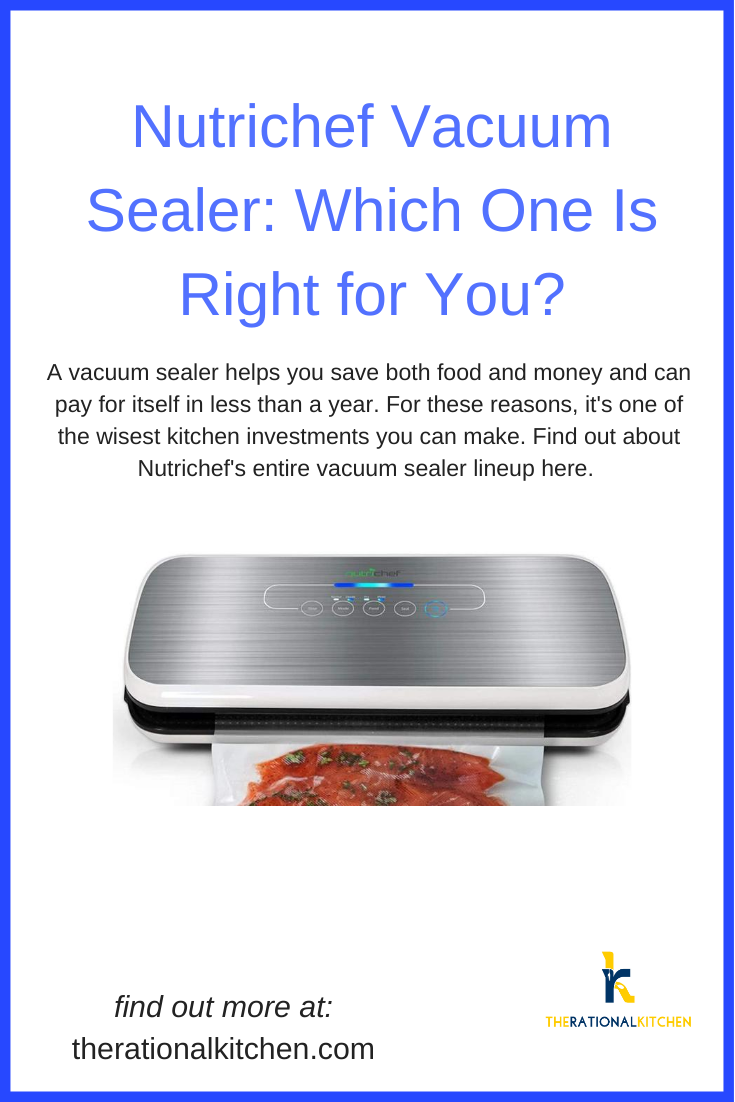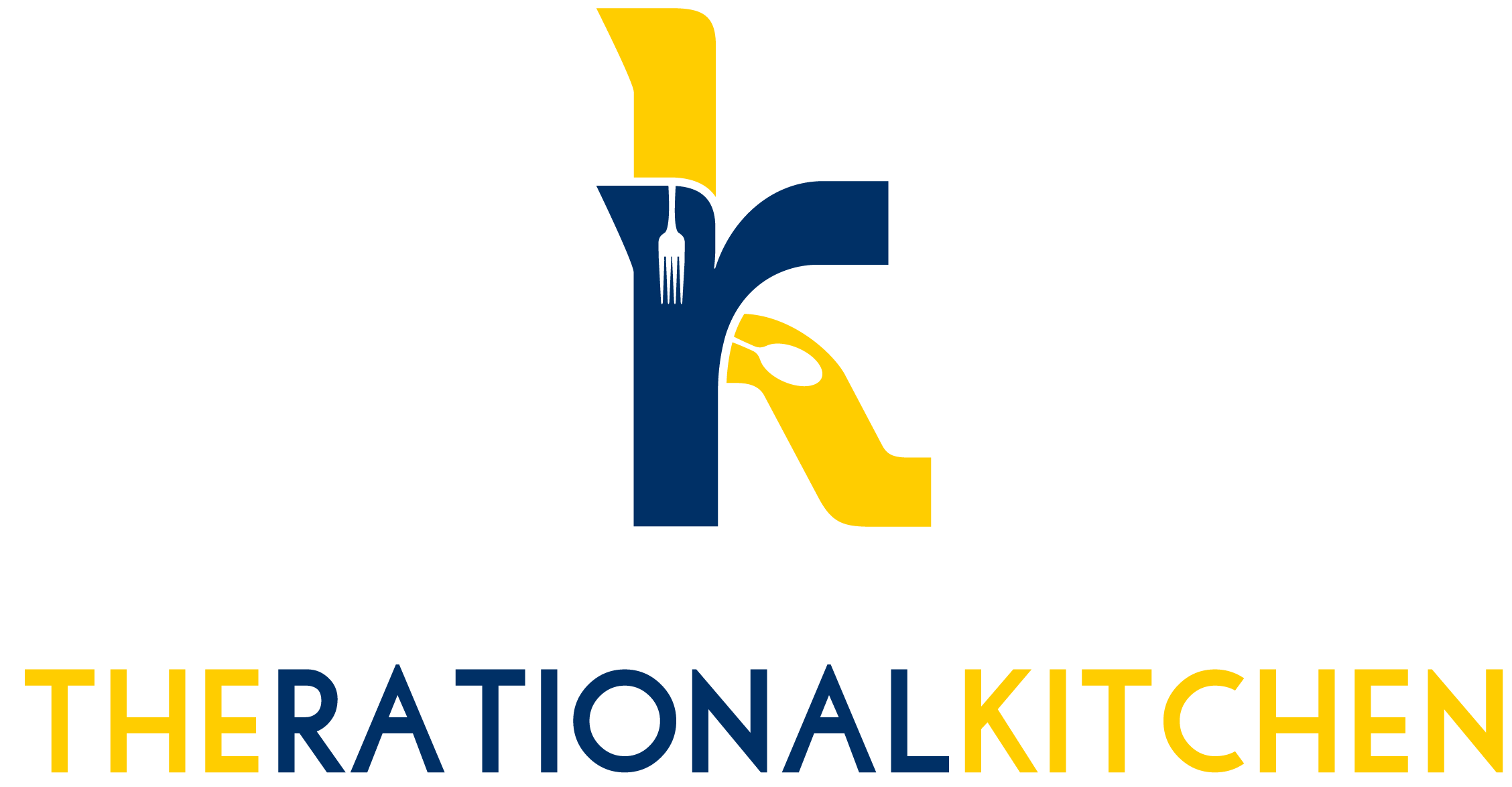Food shortages are predicted to be coming to the US! If that happens, you'll be glad you invested in a vacuum sealer.
Nutrichef makes several models of vacuum sealers, including a chamber vacuum sealer. They are geared toward the home buyer market.
Some Nutrichef models have given FoodSaver real competition. Find out how Nutrichef vacuum sealers stack up against FoodSaver and if they're the right sealer for you.
Nutrichef Vacuum Sealers at a Glance
This table shows all the Nutrichef vacuum sealers. An asterisk indicates a recommended sealer. You can purchase by clicking on a link.
Prices given are approximate and subject to change without notice.
Scroll down to read detailed reviews for each model, including detailed specifications, starter kit contents, and operation.
Note: Table may not be visible in mobile view.
Nutrichef Sealer | Features | Header |
|---|---|---|
-Soft touch digital buttons -LED indicator lights -Built-in bag cutter -Dry/moist sealing modes -Accessory port (hose incl.) -100W motor -About $55. | 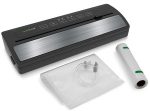 | |
-Soft touch digital buttons -LED indicator lights -Dry/moist sealing modes -Accessory port (hose incl.) -110W motor -About $60. | 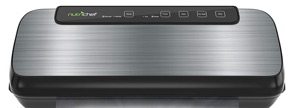 | |
-Soft touch digital buttons -LED indicator lights -Dry/moist sealing modes -Accessory port (hose incl.) -110W motor -About $60. | 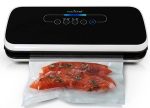 | |
-Soft touch digital buttons -LED indicator lights -Dry/moist sealing modes -Accessory port (hose incl.) -110W motor -About $70. | 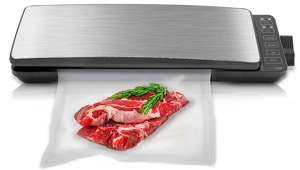 | |
*PKVS30STS | -Soft touch digital buttons -LED indicator lights -3 sealing modes (dry, moist, pickling) -Pulse mode -Accessory port (hose incl.) -120W motor -Bag storage and cutter. -About $80 (don't pay more). | 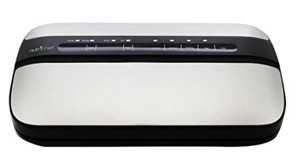 |
-Soft touch digital buttons -LED indicator lights -Digital readout -Dry/Moist, Normal/Gentle sealing modes -Marinate function -Accessory port (hose incl.) -120W motor -About $85. | ||
-Soft touch digital buttons -LED indicator lights -Digital control panel/readout -Dry/Moist sealing modes -Integrated bag cutter -400W -Steel housing -Includes an air hose, 10 bags (11x 15.7”) and 1 bag roll -Weighs about 16 lbs -About $160. | 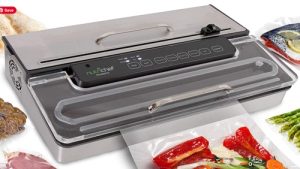 | |
-Digital buttons -8L chamber size -Low, Med, Hi sealing modes -Pressure gauge -350W motor -About 46 pounds -Can seal liquids -About $700. | 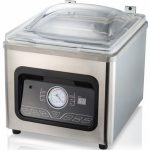 |
Currently unavailable models that may be discontinued (still reviewed below):
Nutrichef Sealer | Features | Header |
|---|---|---|
-Soft touch digital buttons -LED indicator lights -Dry/moist sealing modes -Normal/Gentle sealing modes -Automatic operation -Built-in bag cutter -Accessory port (hose incl.) -120W motor -About $90. |  | |
-Soft touch digital buttons -LED indicator lights -Accessory port (hose NOT incl.) -130W motor -Stain resistant housing -3mm width sealing bar -1 year limited warranty -About $100. |  | |
-Soft touch digital buttons -LED indicator lights -Accessory port (hose incl.) -110W motor -Slim for easy storage -About $40. |  |
About Nutrichef

Nutrichef was founded in 2014, with a mission to "help people eat healthier home-cooked meals."
Nutrichef sells several kitchen products on Amazon and also at Wal-Mart, Home Depot, Wayfair, and a few other retailers. In addition to vacuum sealers they make dehydrators, steamers, sous vide circulators, wine refrigerators, air fryers, utensils, cookware, and more.
Most Nutrichef products carry a one year warranty, including their vacuum sealers.
Nutrichef's parent company is Pyle Audio, which sells a huge array of products including stereos and stereo equipment, bug zappers, watches, and cameras.
From Nurichef's About page:
Our brand was created out of a desire to provide an alternative to fast food convenience and reintroduce people to home cooking. A healthy home-cooked meal is what brings families and friends together. We believe strongly in the value of simple pleasures. An evening spent cooking and sharing a meal of wholesome, nourishing foods is a memory in the making.
All of Nutrichef's products are made in China. For a full catalog of their products, go to the Nutrichef website or Amazon's Nutrichef page.
About Nutrichef Vacuum Sealers (A Short Overview)
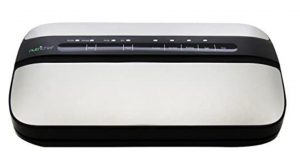
Nutrichef makes standard consumer grade edge vacuum sealers, one commercial grade edge sealer, and one chamber vacuum. If you're confused trying to sort them all out, you're not alone, but this article should help you pick out the right one. We put asterisks by the models we recommend, so they might be a good place to start.
Here are some basic similarities and differences:
All Nutrichef vacuum sealers have an accessory port. All come with the same number of bags and a bag roll. Most come with an accessory hose (one does not). A few models also include a bottle stopper.
One model has automatic Open/Close operation, which is nice if you have strength or ergonomic issues. It is also one of our recommended models.
Most models offer different vacuum speeds--such as Normal/Gentle, Moist/Dry-- and a few have just Vac, Seal, and Stop. None have an included handheld sealer, like some FoodSaver vacuum sealers do (like this one--see it tucked in on the left side), which is odd because Nutrichef calls their sealers "handheld"--note that this does not mean the same thing that it does for FoodSaver vacuum sealers. (It just means that the sealers are small and easy to carry.)
Of the models we review here, the three we recommend all have a bag cutter, which we found to be one of the most useful features (unless you're great with scissors). They have different vacuum speeds, which we found less important. Our recommendations are the PKVS25BK, the PKVS45STS, and the PKVS30STS.
Our favorite model has, in addition to the vacuum speeds and bag cutter, a Pulse button--which, unlike varying vacuum speeds, gives you complete control over the sealing process, making it a useful feature. It is also the only Nutrichef sealer that has bag roll storage, but this makes it bigger and harder to store, so it may not be the best choice for people with limited storage space.
The commercial grade edge sealer also has a bag cutter and Pulse button, and would be a great choice except for all the negative reviews, which make us not recommend it.
If you want to know why we like (and dislike) the features we do, you can find details in the section Buying Considerations below.
We should also note here that Pyle Audio has been accused of offering free stuff in exchange for positive reviews on their vacuum sealers, according to this article. If this is true, you may want to rethink the Amazon reviews. However, you can trust our testing, and our testing shows this: the Nutrichef vacuum sealers are good quality consumer grade products. This means that they're good enough for most casual users, at a reasonable price. For under $100, you can't really expect more than that.
Who Should Buy a Vacuum Sealer?
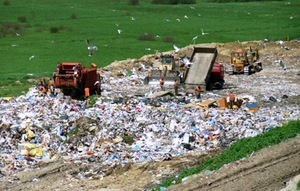
Americans waste a huge amount of food. Some estimates go as high as 40%.
We are fortunate to live in such a rich country, but it's sad that we throw away so much food.
Here's a list of people who could benefit from owning a vacuum sealer:
- Anyone with a large family/large food budget
- Anyone who lives alone and wants to waste less food (or anyone who wants to waste less food)
- People who grow their own fruits and vegetables and want to preserve them
- Hunters and fishermen
- People who like to buy in bulk
- Anyone who hates freezer burn
- Anyone with limited pantry and freezer space (vacuum sealed packages take up less space)
- Anyone who wants their dry goods to stay fresher longer (beans, coffee, rice, pasta, flour and more)
- Anyone who wants refrigerated foods, including leftovers, to last longer
- Anyone who wants to rescue avocados, apples, potatoes, and other leftover produce from browning
- People into sous vide cooking.
In short, anyone who wants to save money and anyone who hates wasting food can benefit from having a vacuum sealer. A small investment can save the average American family up to $2700 a year in food expenses (according to the FoodSaver website).
But even if you spend closer to $1000 on a chamber vacuum sealer, it will still pay for itself in a year or two, depending on how much you use it.
If you want to waste less food and reduce your food budget, a vacuum sealer can literally change your life.
What to Know Before Buying a Vacuum Sealer (A Buying Guide)
Herewe go over basics: different types of vacuum sealers, important features to consider, bags, and more.
If you're in the market for a vacuum sealer, it's good to know what you're shopping for. There are different types of vacuum sealers, and different features from no-frills manual to fully automatic operation. There is also a big price range. If you don't do your homework, you may end up with a sealer that doesn't have the features you want.
Types of Vacuum Sealers
There are three types of vacuum sealers: external sealers, chamber sealers, and handheld sealers. All three types of vacuum sealers have their pros and cons.
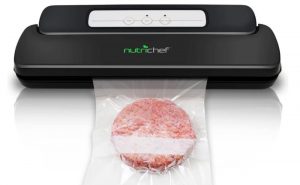
External sealers (pictured above) are the most common type, and what most people think of when they think "vacuum sealer." External sealers, also known as edge sealers or channel sealers, seal the bag externally (thus the name): that is, they have a channel into which you insert a bag to vacuum and seal it. External sealers range in price from under $50 to several hundred dollars; in general, the more you pay, the sturdier the sealer and the stronger the vacuum pull. (However, note that vacuum strength doesn't tend to improve until you're above the $300-or-so point.)
External sealers also range from basic, manual operation all the way up to fully automatic sealing that will even cut the bag for you.
There are a number of features available on edge sealers; we talk about the most important ones below under Buying Considerations.
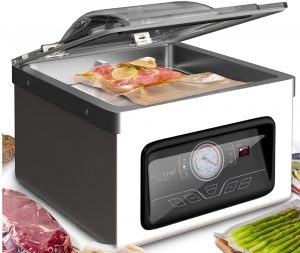
Chamber sealers (pictured above) are a larger, heavier type of vacuum sealer. Rather than evacuating air from just the bag, like an edge sealer, a chamber sealer evacuates air from an enclosed chamber. Because the air pressure inside and outside the bag are the same, you can seal liquids in a chamber sealer. You can also seal other containers inside a chamber sealer, such as mason jars and marinade containers--pint jars work well, or you can lay quart jars laid on their sides. (No accessory hose needed.)
Chamber sealers are more expensive than all but the very top end edge sealers; they start around $500 and go up in price to over $1000. Chamber sealers are built primarily for commercial use, so they're great for big sealing projects: it's not necessary to provide cool down periods as you need to with consumer grade edge sealers, so big projects go a lot faster.
While most people balk at the initial investment of a chamber sealer, they are nevertheless an excellent purchase for anyone who's going to be doing a lot of vacuum sealing. The bags are quite a bit less expensive than edge sealer bags, so your ongoing expenses are lower. If you become serious about food preservation, there may be a chamber sealer in your future.
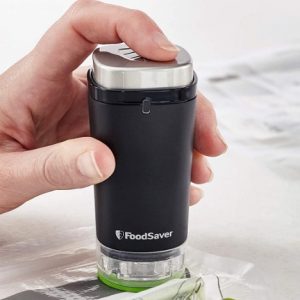
Handheld sealers (pictured above) are just that: small sealers that fit in your hand and are used with proprietary zip-top, reusable bags. They are excellent for food items that you'll want to open and re-seal (e.g., cookies, crackers, cheeses, leftovers). Though the bags are the most expensive and the vacuum pull is the weakest of all three types of sealers, handheld sealers are nevertheless useful.
Here's an example of a handheld sealer.
Some edge sealers come with a built-in handheld sealer, such as this model from FoodSaver. Having both types of sealing technology can be great, but keep in mind that you need to buy two types of bags.
If you want to learn more about handhelds, see our article The Best Handheld Vacuum Sealers.
About Vacuum Sealer Bags
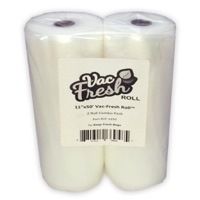
The largest ongoing expense of owning a vacuum sealer is the bags. You should do enough research to understand approximately how much you'll be spending on bags for your vacuum sealer.
Vacuum sealers require special bags to work properly. Handheld sealers remove air through a special hole. Edge sealers require bags with internal ridges that help to "push" air out of the bag. Chamber sealer bags have the simplest technology, with bags that are smooth inside and out, and are also the least expensive of the three types.
For edge sealers, you have the option of buying pre-made bags in boxes, or rolls of bags that you can cut to a desired length (bag rolls are pictured above). It's a good option because bag rolls are less expensive than pre-cut bags (sometimes considerably less expensive).
Note also that regardless of what the manufacturer might tell you, you do not need to buy name brand bags for any sealer. Less expensive generic brand bags work fine as long as you buy the correct type of bag.
Here are some links so you can compare bag prices on Amazon.
For more detailed information, see our article How to Buy the Best Food Vacuum Sealer Bags (For the Best Price).
Buying Considerations
These are the important features to learn about before buying a vacuum sealer.
Vacuum Strength

Vacuum strength refers to how much vacuum a sealer can actually create. If you buy a commercial grade vacuum sealer, this information is always provided, since that's what you're paying the big money for: the ability to pull a strong vacuum.
With consumer grade vacuum sealers, vacuum strength is often not given. FoodSaver, for example, considers their vacuum strength proprietary, so they do not provide it. Their focus is more on features such as automated sealing and other options that appeal to consumers.
Vacuum strength is the most important feature of a vacuum sealer: the more air a sealer can remove from a bag, the longer your food is preserved. Thus, vacuum strength is a useful piece of information when buying a sealer.
For vacuum sealers, vacuum strength is typically given in inches of mercury (abbreviated as inHg or "Hg), and it can vary considerably. What's a good number? Well, 29.92 inHg is considered the highest vacuum you can attain in the earth's atmosphere. (That may sound arbitrary, but there is science behind it.) Commercial and chamber sealers can attain 26-29 inHg. Consumer grade edge sealers range from about 15 inHg to about 24 inHg.
Thus, the difference between consumer grade and commercial grade vacuum sealers is considerable: consumer grade sealers remove 60-70% of air from a bag, while commercial grade sealers remove closer to 90%.
For food preservation, this is a big difference.
You will still benefit from a consumer grade vacuum sealer: removing 70% of the air results in much better food preservation than no vacuum sealer. Therefore, a consumer grade edge sealer can still be an excellent purchase.
To Nutrichef's credit, they include vacuum strength for most of their models: 17.7 inHg. Our testing confirms that this is, in fact, the vacuum strength for all the consumer grade Nutrichef edge sealers that we reviewed (we rounded to 18 inHg). This is a favorable number compared to many other consumer edge sealers.
The NutriChef commercial grade edge sealer pulls 26 inHg, which is better than consumer grade sealers, but not as good as some other commercial grade edge sealers (like Weston).
The Nutrichef chamber sealer pulls 26 inHg, which isn't great compared to other chamber sealers we've reviewed (like VacMaster and Avid Armor).
If you're buying a consumer grade sealer, you're going to get a vacuum strength of 15-24 inHg, even if that number isn't given. Nutrichef vacuum sealers pull about 18 inHg, which is a respectable number for a consumer grade sealer.
Vacuum Speed
Vacuum speed refers to how fast a sealer evacuates air from a bag. The rate of air removal is fairly standard among Nutrichef edge sealers and hovers around 12L/min, which translates to about 5 seconds per 1-quart bag. A few models are slower.
The PKVS30STS (or see detailed review below), however, is rated at 24L/min, which translates to just under 3 seconds per 1-quart bag. This sealer also has several other features we love, for not a lot more than other models, so it is our favorite recommended Nutrichef sealer.
Vacuum speed is fairly standard among Nutrichef edge sealers, but if you want a super fast one, go with the Nutrichef PKVS30STS model, which also has other features we love (Pulse button, bag cutter).
Different Vacuum Modes
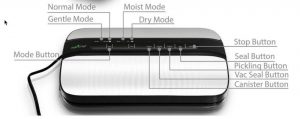
Some edge vacuum sealers simply have a Seal, Seal/Vac, and Stop buttons. Others have Dry/Moist options. Some have a Normal/Gentle vacuum speed.
Are extra vacuum speeds useful? Yes and no. The truth is that you can control all your vacuum operations by observing and pressing the Stop or Seal button at any point in sealing process. So even with a totally no-frills sealer, you can exercise plenty of control over the process.
However, the extra vacuum modes can be useful. Gentle mode is good for delicate foods like bread and crackers; it slows the speed so you have less chance of crushing your food. And Moist mode is nice because it causes the heat seal to go a little longer just in case moisture interfered with proper sealing (as it will often do).
Are any of these features necessary? Not really. As we said, you can do all of these things manually by using the Stop button. And, these extra modes don't always work that well--for example, if you think the Moist mode will allow you to seal liquids with an edge sealer, you're in for a rude awakening. There are workarounds (such as freezing) that allow you to seal liquids, but the Moist button is not one of them.
So if you have the extra buttons, you'll probably get some use from them. But if you don't, you probably won't miss them all that much.
Nutrichef offers several sealers with different vacuum modes, many for around the same price as those that don't have them. We suggest that you don't choose a sealer for the extra sealing modes but rather for the bag cutter, Pulse feature, or--best of all--superior vacuum strength. These were the features most appreciated (although superior vacuum strength means paying more for a vacuum sealer).
Different vacuum speeds are nice, but you can also control the process by stopping before you crush the food. You'll use them if you have them, but you probably won't miss them if you don't.
Pulse Feature
Unlike the different vacuum modes, a Pulse feature is really useful. It replaces the need for other buttons as it allows you to stop and start the vacuum process until you zero in on exactly the right amount of vacuum. In other words, it gives you full control over sealing.
You can do this by just pressing the Stop button at the right time, but Pulsing lets you re-start if you hit Stop too early.
A Pulse button gives you full control over the sealing process and is the most useful vacuum mode button a sealer can have. The Nutrichef models PKVS30STS and PKVS50STS have a Pulse button.
Accessory Port
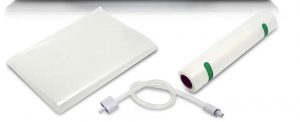
An accessory port allows you to attach a hose to the vacuum sealer to seal external containers, including marinade containers, mason jars (with special lids), bottle stoppers, and even handheld sealers (for use with special zip-top bags). This is a nice feature you are likely to get a fair amount of use out of if you invest in the accessories.
All the Nutrichef vacuum sealers have an accessory port, and most of them include a hose. The bad news is that the Nutrichef accessory hose is only a little over a foot long, which is inconveniently short.
If you have an accessory hose and/or containers from an old vacuum sealer, they should work with the Nutrichef sealer, even if it's a different brand. Vacuum sealer accessories tend to be universal, so you can buy any hose or any containers to go with your Nutrichef vacuum sealer.
It's a great feature that you are likely to find useful.
An accessory port is a feature that allows you to seal external containers. This expands the usefulness of your vacuum sealer to mason jars, marinade containers, storage containers, handheld sealers, and bottle stoppers.
All Nutrichef sealers have an accessory port, but not all of them come with a hose. You will also have to buy most of the accessories separately--but they are inexpensive, and any brand should work with a Nutrichef sealer.
Sealing Bar Length
Standard sealing bar length is 11 inches, and if not stated, you can assume that's what a vacuum sealer has. You can find vacuum sealers with longer sealing bars, such as this Weston model, but you'll pay more for them. Keep in mind also that bigger bags are more expensive, so as appealing as a longer sealing bar might sound, you may not get the use out of it you think you will.
A longer sealing bar also adds weight and bulk to the sealer.
Standard sealing bar length is 11 inches--actually slightly longer--so you can seal 11-inch wide bags.
Roll Storage
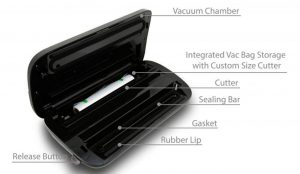
Some vacuum sealers have a storage compartment for bag rolls. This is a good feature, but it makes the sealer bigger. And in the case of Nutrichef's PKVS30STS--the only Nutrichef sealer we tested that has roll storage--the compartment is only large enough for small bag rolls.
Roll storage makes it more convenient to use bag rolls, which are cheaper than pre-cut bags. However, we don't consider it a necessity. Our favorite Nutrichef model has bag storage, but we love it for other reasons.
Bag roll storage is nice, making it convenient to use rolls of bags, which are cheaper than pre-cut bags. However, it also adds size and bulk to a vacuum sealer, and may not provide enough storage for large rolls, making the functionality iffy.
Bag Cutter
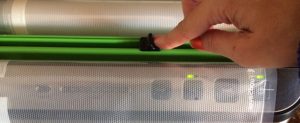
A bag cutter is a great feature. You may think using a scissors isn't a big deal and while that's true, a bag cutter is just so.much.easier. to use than scissors. You get a perfect cut every time, effortlessly.
We strongly recommend getting a sealer with a built-in bag cutter because they make the sealer easier to use.
Once again, our favorite model, the Nutrichef PKVS30STS has a bag cutter. Other Nutrichef sealers we recommend (marked by asterisks in the table above and the reviews below) also have a bag cutter.
A bag cutter may not sound like a very useful feature, but it's one of the best features you can have. It makes using bag rolls (which are cheaper) effortless, ensuring a perfectly straight cut every time.
2-in-1 Handheld Sealer
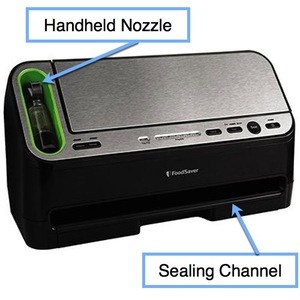
A 2-in-1 vacuum sealer is an edge sealer that also has a handheld sealer which is used with resealable, zip-top bags. It's a nice feature because edge-sealed bags need to be cut open and can't easily be re-used, but handheld sealer bags are designed for re-use. The zip-top seal makes them easy to re-use and makes these bags great for leftovers--though not so great for freezers or long-term pantry storage. The seal isn't as strong, plus you don't want the fairly expensive bags tied up with long-term storage.
FoodSaver makes several 2-in-1 vacuum sealers, like the one pictured above. Nutrichef does not make any 2-in-1 sealers that we are aware of, although you can use the accessory port with a separately purchased handheld sealer (you'll probably have to buy a FoodSaver brand).
Note here that even though Nutrichef calls several of their edge sealers "handheld" sealers, they are not this type of handheld. In the case of Nutrichef edge sealers, "handheld" probably refers to the sealers being small and light (easy to hold in your hand).
Nutrichef doesn't make any 2-in-1 sealers that we know of, however, if you want one, you can probably use a separately purchased handheld sealer with a Nutrichef accessory port.
Starter Kit
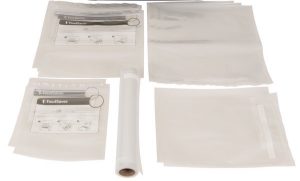
The starter kit is basically all the accessories that come with a vacuum sealer, including the number of bags. Since bags are the biggest ongoing expense with using a vacuum sealer, it's worth paying attention to.
Nutrichef vacuum sealers have a standard package that includes 5 medium-sized bags, one medium bag roll (8-in. wide), and an accessory hose. A few also come with a bottle stopper; one has no accessory hose.
This isn't the most generous starter kit we've seen, but it's not the worst, either. Everything that comes with the sealer purchase is something you won't have to buy later--so everything that's included is a plus.
We recommend that you buy a few rolls of bags when you order a vacuum sealer, especially large (11-inch wide) bag rolls. You will probably use up the starter kit bags getting the hang of using the sealer, and you won't want to wait for more bags to keep using it.
A starter kit is everything included when you buy your vacuum sealer. For Nutrichef, this usually means 5 bags, one small bag roll, and an accessory hose (but check to be sure). Since bags are the biggest ongoing expense, this is a good thing--but we recommend buying a roll or two of bags when you buy the sealer. You're definitely going to need them.
Noise
Make no mistake, vacuum sealers are noisy. The average edge sealer runs between 70 and 80 decibels. This makes it about as loud as a powerful blender.
Chamber sealers and handhelds are quieter. But since the edge sealer checks the most number of boxes for the most number of buyers, we don't recommend getting another type of sealer for the noise alone.
Somewhat surprisingly, many reviewers of Nutrichef vacuum sealers claimed that they thought the sealer was quieter than previous brands they'd owned. We did not find a huge difference in our testing, though.
An edge vacuum sealer is about as noisy as a blender. There's not a lot you can do about this, but it's something to be aware of.
Where Is the Vacuum Sealer Made?
Most vacuum sealers--of all types--are made in China. This includes the Nutrichef brand.
There's not a lot else to say about this, but it's something buyers are curious about, so we include the country-of-origin info. (If you know of any brands made in the US, please let us know!)
NOTE: The original FoodSaver vacuum sealers--made in the 1990s and before--were made in Italy, and they have a reputation for being built like tanks and running forever. If you come across an old FoodSaver vacuum sealer, you should snap it up.
Most vacuum sealers are made in China today, including Nutrichef vacuum sealers.
Budget, Warranty, and Customer Service
Finally, a word about budget, warranty, and customer service. Being that most vacuum sealers are made in China, the price, quality, and customer service are all about the same, especially for consumer grade edge sealers. That is to say, not always great. A number of reviewers complained about customer service for Nutrichef sealers, saying it was bad or even nonexistent.
This is not surprising, being a made-in-China product. However, the price is good, and we think they are worth a look if you're in the market for an inexpensive edge sealer (under $100). And since the quality doesn't really improve until you spend upwards of $300, most people are willing to take the risk.
One really good way to protect yourself is to buy the Amazon extended warranty. For only a few extra dollars, you can ensure that you'll be covered should your vacuum sealer die unexpectedly. If you're on a tight budget, that's the best thing you can do when buying an inexpensive vacuum sealer.
On the other hand, if you can afford a more expensive sealer, you may want to look into Weston or VacMaster sealers. Though made in China, they offer robust, commercial grade products--and with the higher price comes better customer service, too.
We understand that if you're new to vacuum sealing you may not want to make a large initial investment. But if you can, it's a smart way to go.
Do I Need to Buy Nutrichef Brand Vacuum Bags (And Accessories)?
No, you do not need to buy Nutrichef bags. You can use any brand of vacuum bag as long as it's the correct type of bag for your sealer.
We repeat this information because many manufacturers insist that you need to use their brand bags with their sealers. This is not the case.
Since bags are the biggest ongoing expense of vacuum sealing, you should shop around for the cheapest bags you can find that work with your sealer.
Will you have more failures with cheaper bags? Possibly. But you will have a percentage of failures regardless what brand of bag you buy. We highly recommend trying generic, no-name brands until you find the least expensive ones that work with your sealer. Doing so will save you money in the long run.
The same goes for accessories: most edge sealer accessories are universal, so you can buy any brand and it should work with your Nutrichef vacuum sealer. Since the Nutrichef accessory hose is just over a foot long (short), you may want to buy a different brand of accessory hose, too.
For more info on bags, see our article How to Buy the Best Food Vacuum Sealer Bags (For the Best Price).
You can--and should--use non-brand name bags with your vacuum sealer. This will save you money in the long run, as bags are the biggest ongoing expense of vacuum sealing.
Same goes for accessories, which are mostly universal for all brands of edge sealers.
Are Vacuum Sealer Bags Recyclable? Are They Reusable?
Some vacuum sealer bags are recyclable.
Chamber sealer bags are recyclable, and re-usable zip-top bags used with handheld sealers may be recyclable. In general, these bags can go in with plastic grocery bags (not with your curbside plastics)--but check with your local recycling center to make sure.
As far as we know, edge sealer bags are not recyclable. They contain plastic and nylon, which makes them ineligible for most plastic recycling programs.
What about reusability? Interestingly, Nutrichef claims that their edge sealer bags are "re-usable." Few makers of vacuum sealer bags suggest that you can wash and re-use their edge sealer bags. In fact, most makers encourage you to dispose of bags after one use. This is because of contamination--bacteria and other pathogens may live in a bag and contaminate the next food you put into it (even if it looks clean). This is especially true if the bag was used for raw meat or fish.
Another issue with edge sealer bags is that they require a fair amount of bag to seal (a few inches, at least), and then you must cut the bag open in order to eat the food inside. Therefore, though you can technically wash and re-use these bags, there often isn't a lot of bag left for re-use.
So, if you've used an edge sealer bag for a fairly clean or dry food--crackers, bread, maybe produce--and there's enough bag left to fill and re-seal, then yes, you can re-use edge sealer vacuum bags. But they aren't meant to be re-used, and you'll probably find that you can't re-use these bags much of the time.
Another way to get more use out of a bag is to use it for multiple tasks. For example, use the bag to freeze, then use it in a sous vide bath to cook, then maybe even use the same bag to store the leftovers.
You can also use storage containers and mason jars with your accessory hose to cut down on bag use--this is an excellent way to get plenty of use out of your sealer with almost no plastic bag waste at all.
Yet another way to minimize your plastic use--even though you really want a vacuum sealer--is to buy a chamber sealer, because the bags are recyclable, or to buy a handheld sealer, because the bags are designed for re-use. Either option will cut down on your plastic bag use.
It's important to understand about plastic use with vacuum sealers because plastic waste is a real issue. If you're careful and thrifty, you can keep plastic waste to a minimum. But no matter how careful you are, you're still going to go through a fair amount of non-recyclable plastic bags with an edge vacuum sealer.
Edge vacuum sealer bags are not recyclable. Chamber sealer bags are recyclable. Some handheld sealer bags may be recyclable.
You can cut down plastic waste by re-using bags when possible, and also by using other containers with the accessory hose.
Is It Smart to Buy a Vacuum Sealer on Amazon?
We think Amazon is an excellent place to buy a vacuum sealer because it gives you an extra level of security. For products that are made in China and can have iffy (or even nonexistent) customer service, the peace of mind that creates makes it a great place to buy.
Buying an Amazon extended warranty is especially smart, but even without one, Amazon will process a return within 30 days with no questions asked. They will often replace a product for no extra charge, too.
Other retailers will also do this, but Amazon is one of the simplest to deal with. This is especially true if you have an Amazon Prime account, which makes everything easier.
Amazon also has the most comprehensive user rating and review system of any website. As a product review website, we find a lot of gold in the product reviews and highly recommend reading the Amazon reviews before buying any product.
For more information, see our articles Can You Trust Amazon Reviews? and How to Buy Online: Teach Yourself About Technical Products and Get What You Can Truly Love.
Amazon is a smart place to buy a vacuum sealer because they have their own warranty and return programs. The extended Amazon warranty is also a good idea for any expensive appliance because it gives you peace of mind--especially useful for products made in China that may have poor customer service.
*Review: PKVS25BK

See PKVS25BK on Amazon (2018 model)
See PKVS25BK on Amazon (newer model)
About $55
Buy for: Bag cutter, several vacuum modes, good vacuum speed.
The Nutrichef PKVS25BK is a standard edge style vacuum sealer. It has a few nice features, like the Dry and Moist sealing modes and the Normal and Gentle sealing modes: the Moist mode seals longer in order to compensate for any liquid that may have gotten into the sealing area, while the Gentle pulls lighter vacuum for delicate foods like bread. You can also stop the vacuum process at any time by pressing the Stop button.
The automatic bag cutter is a great feature as it's always difficult to get a straight cut using scissors. The LED indicator lights always let you know where you are in the sealing/vacuuming process. The 3mm width seal is also excellent, ensuring you won't easily get leaks.
The less expensive model includes one roll of bags and the "upgraded" model includes two rolls of bags. Otherwise, the two models are identical.
Features
- Soft touch digital buttons
- LED indicator lights
- Built-in bag cutter
- Dry/Moist sealing modes
- Normal/Gentle sealing modes
- 3mm width seal
- Accessory port (hose incl.)
- 100W motor
- Generous starter kit
- Rated at 12L/min (so about 5 seconds to seal a 1 quart bag)
- Vacuum strength about 18 inHg
- 1 year limited warranty.
Operating Instructions
The control panel looks like this:

To use the accessory port, attach the hose and use the Canister button (far left).
Operation is simple. From the Nutrichef website:
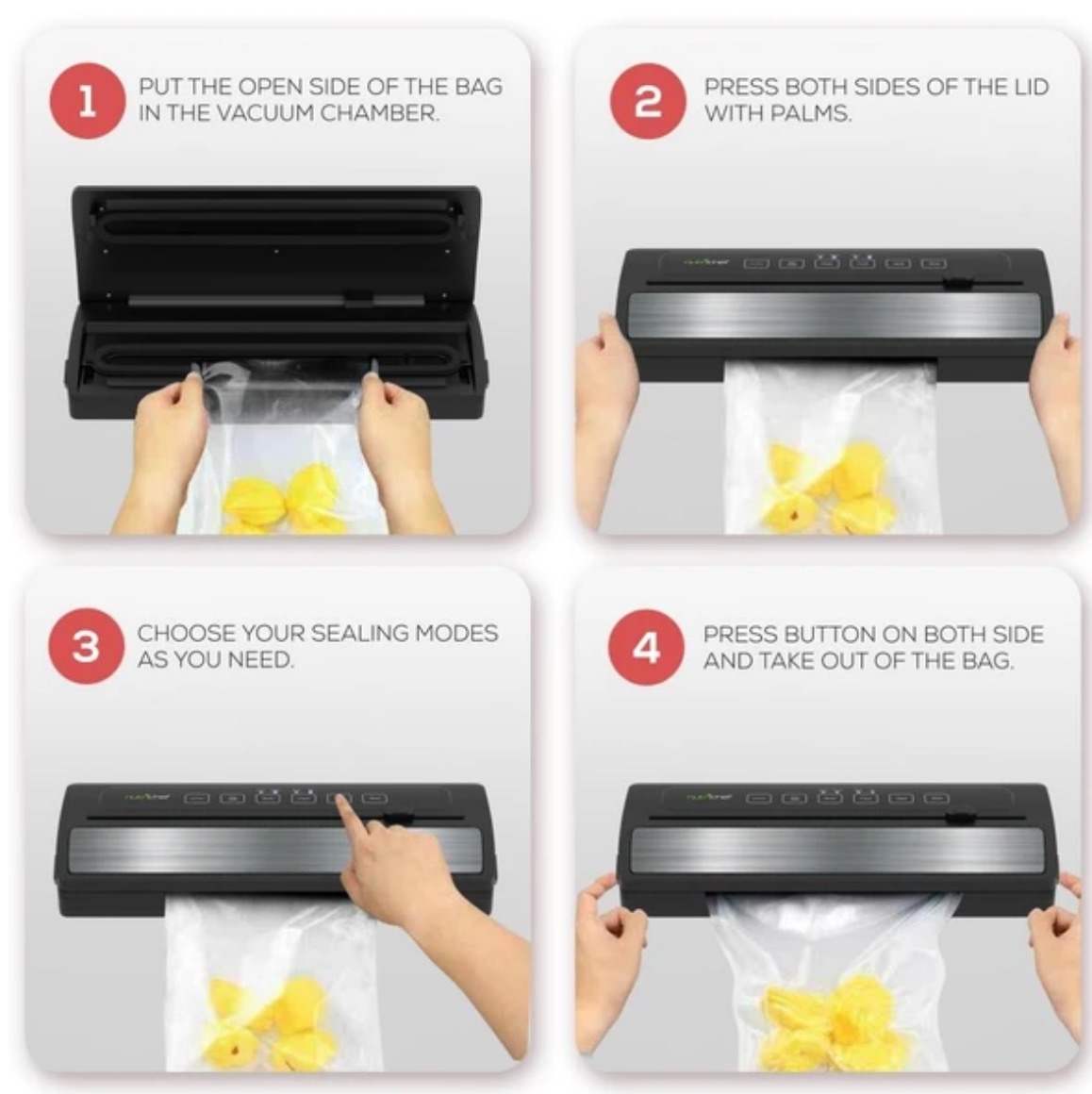
As you can see, it's easy to use, but it does require two hands to lock down and to open. This is not unusual for edge sealers, but it can be a bit of a pain.
You can use the Moist button for sealing wet or delicate foods, but all it does is pull less vacuum. Another workaround is to freeze liquids before sealing.
Specifications
Color: Black/stainless
Size: 14.4 x 5.5 x 3.0 in.
Weight: 4.05 lb
Max Bag Width: 11 in.
Power: 100W
Vacuum Strength:18 inHg
Edge Sealing without Vacuum Capability? Yes (Seal button)
Accessory port? Yes (hose included)
Storage space for bags? No
Bag Cutter? Yes
Warranty: 1 year limited.
Included

5 Medium vacuum bags (7.8 x 11.8 in.)
1 Bag roll (7.8 x 79 in.)
Accessory Hose
Power cord.
Note: The "upgraded" model contains 2 rolls of bags.
Pros and Cons
Pros
Cons
Recommendation
Rated at just under 18 inHg vacuum strength and a 100W motor makes this sealer about average for consumer grade sealers, few of which can do better than 20 inHg. The built-in bag cutter, accessory port, and several vacuum speeds make it a good choice for anyone looking for a basic sealer well under $100.

BUY NUTRICHEF PKVS25BK ON AMAZON (Extra bag roll):
BUY NUTRICHEF PKVS25BK ON AMAZON (one bag roll):
BUY NUTRICHEF PKVS25BK at wal-mart:
*Review: PKVS45STS
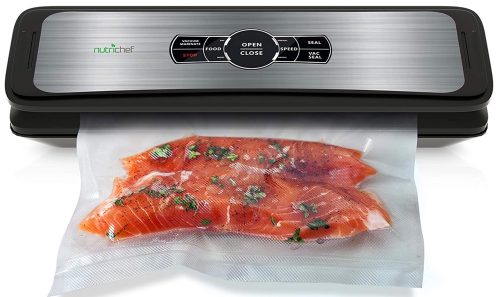
About $90
Buy for: bag cutter, several vacuum modes, automatic operation.
At about $60, the PKVS45STS is a nice vacuum sealer. You get an accessory port and four vacuum speeds, plus a neat little removable bag cutter to easily slice rolls of bags quickly and evenly. You get a slightly more powerful motor than most other Nutrichef edge sealers at 120W. However, this isn't enough to notice a huge difference in sealing speed or strength.
In fact, at 8L/min, vacuum speed is slow--one of the slowest Nutrichef vacuum sealers on the market. If it weren't for the slow vacuum speed, this would be a TRK recommendation, but the PKVS25BK (reviewed above) and the PKVS30STS (reviewed below) have similar features for around the same price, and are both faster.
The neatest thing about this sealer is the interface: all the buttons are front and center, which makes it easy to operate. This includes the Open/Close, which is automatic on this vacuum sealer (no manual locking down of the lid).
Features
- Soft touch digital buttons
- LED indicator lights
- Built-in bag cutter
- Automatic open/close
- Dry/moist sealing modes
- Normal/Gentle sealing modes
- Marinade button
- Accessory port (hose incl.)
- 120W motor
- Rated at 8L/min (about 7.5 seconds to seal a 1 qt bag)
- Vacuum strength about 18 inHg (from our testing)
- Generous starter kit
- 1 year limited warranty.
Operation
Operation is all electronic with this vacuum sealer, which is a nice feature. In addition to the Moist/Dry foods, it also has a marinade setting and Fast/Slow vacuum speeds, all offering maximum control over the vacuum sealing process:
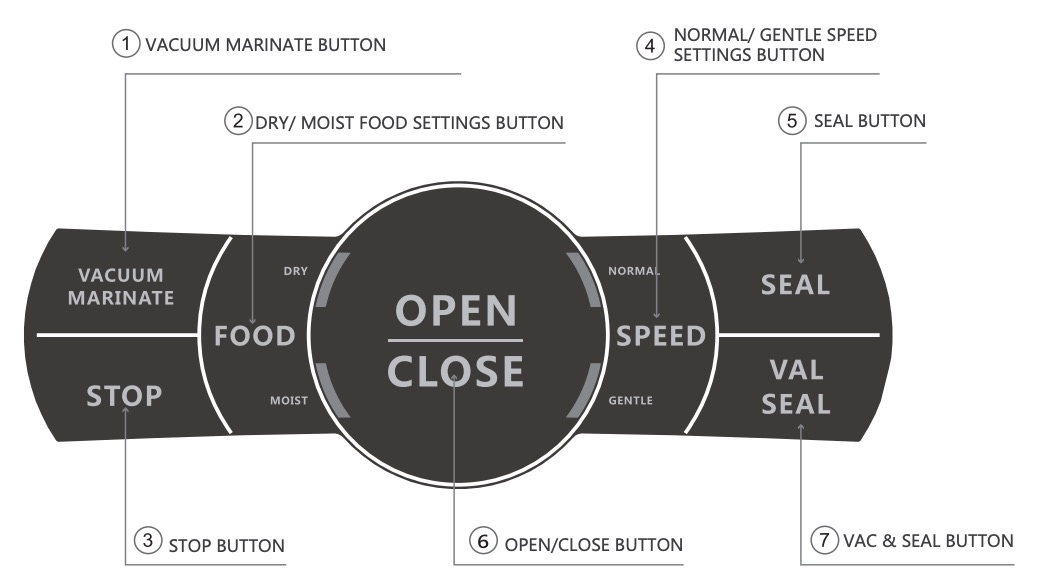
There is also an accessory port, so you can the sealer for marinade containers, wine bottles, etc. The accessory hose is included with purchase, but the accessories are sold separately. (Note: Most accessories made by other companies, such as FoodSaver, should work with Nutrichef vacuum sealers--a good thing to know if you've got accessories on hand from an old vacuum sealer.)
Specifications
Color: Black/stainless
Size: 14.9 x 5.5 x 2.7 in.
Weight: 4.8 lb
Max Bag Width: 11 in.
Power: 120W
Vacuum Strength:18 inHg
Vacuum Speed: 8L/min
Accessory Port? Yes (hose included)
Edge Sealing without Vacuum Capability? Yes (Seal button)
Storage space for bags? No
Bag Cutter? Yes
Warranty: 1 year limited.
Included
5 Medium vacuum bags (7.8 x 11.8 in.)
1 Bag roll (7.8 x 79 in.)
Accessory Hose
Power cord.
Pros and Cons
Pros
Cons
Recommendation
For about $60, the Nutrichef PKVS45STS is a nice sealer with about all the features you could want on a consumer grade sealer except for bag storage. The only thing we don't like about it is its vacuum speed which, a 8L/min, is pretty slow. But the automatic open/close is a nice feature, especially if you have strength or mobility issues.
BUY NUTRICHEF PKVS45sts:

Review: PKVS20STS
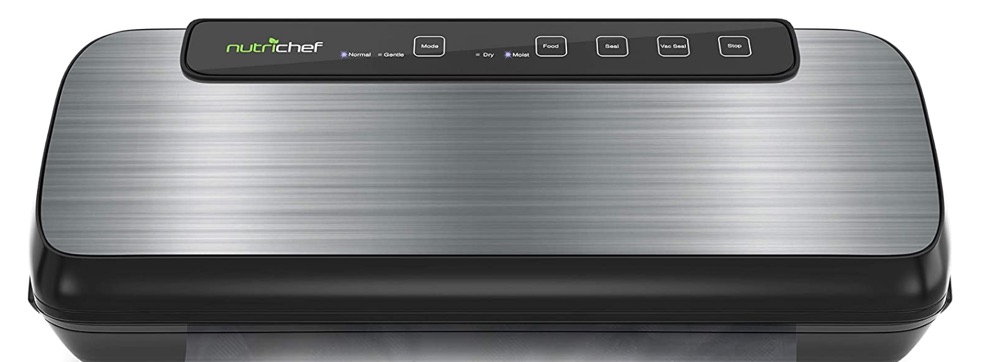
About $60
At about $60, the Nutrichef PKVS20STS vacuum sealer is in the middle of the pack and doesn't really distinguish itself as anything special. It has several vacuum modes, which is nice, and the starter kit includes a wine stopper, also nice. But like many other Nutrichef sealers, it does not have a bag cutter, which we count as a big miss. For about the same price, you can get a Nutrichef sealer with all the same features and a bag cutter, which makes using bag rolls so much easier. For slightly more, you can get one with roll storage, too--though it will only work with very small bag rolls. We recommend the PKVS25 and PKVS45 models over this one, or if you want roll storage, the PKVS30STS.
Features
- Soft touch digital buttons
- LED indicator lights
- Dry/moist sealing modes
- Normal/gentle sealing modes
- 3mm seal width
- Vacuum strength: 18 inHg (from our testing)
- Vacuum speed: 12L/min (about 5 seconds for a 1 qt bag)
- Accessory port (hose incl.)
- 110W motor
- Generous starter kit
- 1 year limited warranty.
Operation
Here's the control panel:

And here are operating instructions, from the manual:
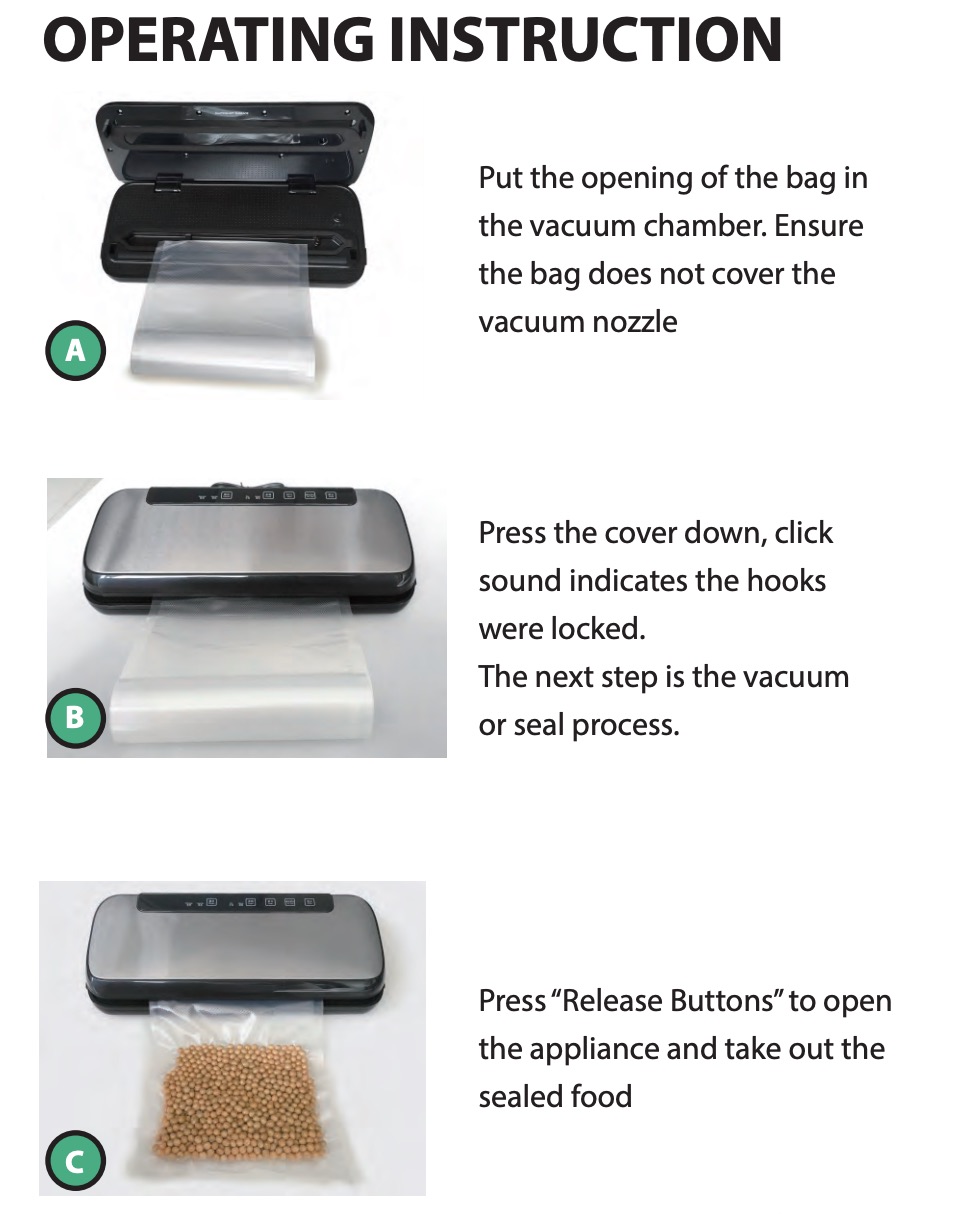
Specifications
Color: Black/stainless
Size: 14.2 x 6.0 x 3.0 in.
Weight: 3.0 lb
Max Bag Width: 11 in.
Power: 110W
Vacuum Strength:18 inHg
Vacuum Speed: 12L/min
Edge Sealing without Vacuum Capability? Yes (Seal button)
Storage space for bags? No
Roll Cutter? No
Warranty: 1 year limited.
Included
5 Medium vacuum bags (7.8 x 11.8 in.)
1 Bag roll (7.8 x 79 in.)
Accessory Hose
Wine stopper (for use with accessory hose)
Power cord.
Pros and Cons
Pros
Cons
Recommendation
For about the same price, you can get a Nutrichef sealer with a built-in bag cutter. Or, for a little more, you can get one with roll storage, too (though it only accommodates small rolls). We recommend going with the PKVS25 and PKVS45 models (both reviewed above) if you don't care about roll storage, or the PKVS30STS if you do.
BUY NUTRICHEF PKVS20STS:

Review: PKVS10BK/PKVS10WT
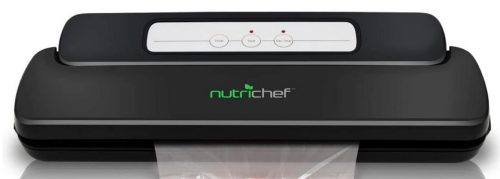
See PKVS10BK on Amazon (black)
See PKVS10WT on Amazon (white)
About $100
The Nutrichef PKVS10 vacuum sealer is a no-frills model. It has no special sealing options such as for Moist foods, just Stop, Seal, and Vac and Seal. On the other hand, this makes it a very straightforward, easy vacuum sealer to operate.
It also has an accessory port for sealing mason jars, marinade containers and wine bottles, but you have to buy the hose separately. (If you have a hose from another vacuum sealer, it will work--so if you're replacing a FoodSaver or other brand, this model might be the way to go).
At 130W, this is one of Nutrichef's motr powerful sealers. But again, you aren't going to notice a lot of difference from those few extra watts. Unfortunately, this lightweight little sealer does not have a bag cutter, either, so be prepared to use scissors; it might not sound like a big deal, but a cutter makes it easy to get a straight, even cut every single time.
Features
- Soft touch digital buttons
- LED indicator lights
- Accessory port (hose NOT incl.)
- 130W motor
- Stain resistant housing
- 3mm width sealing bar
- Vacuum strength about 18 inHg (from our testing)
- 1 year limited warranty.
Operation
From the PKVS10 manual:
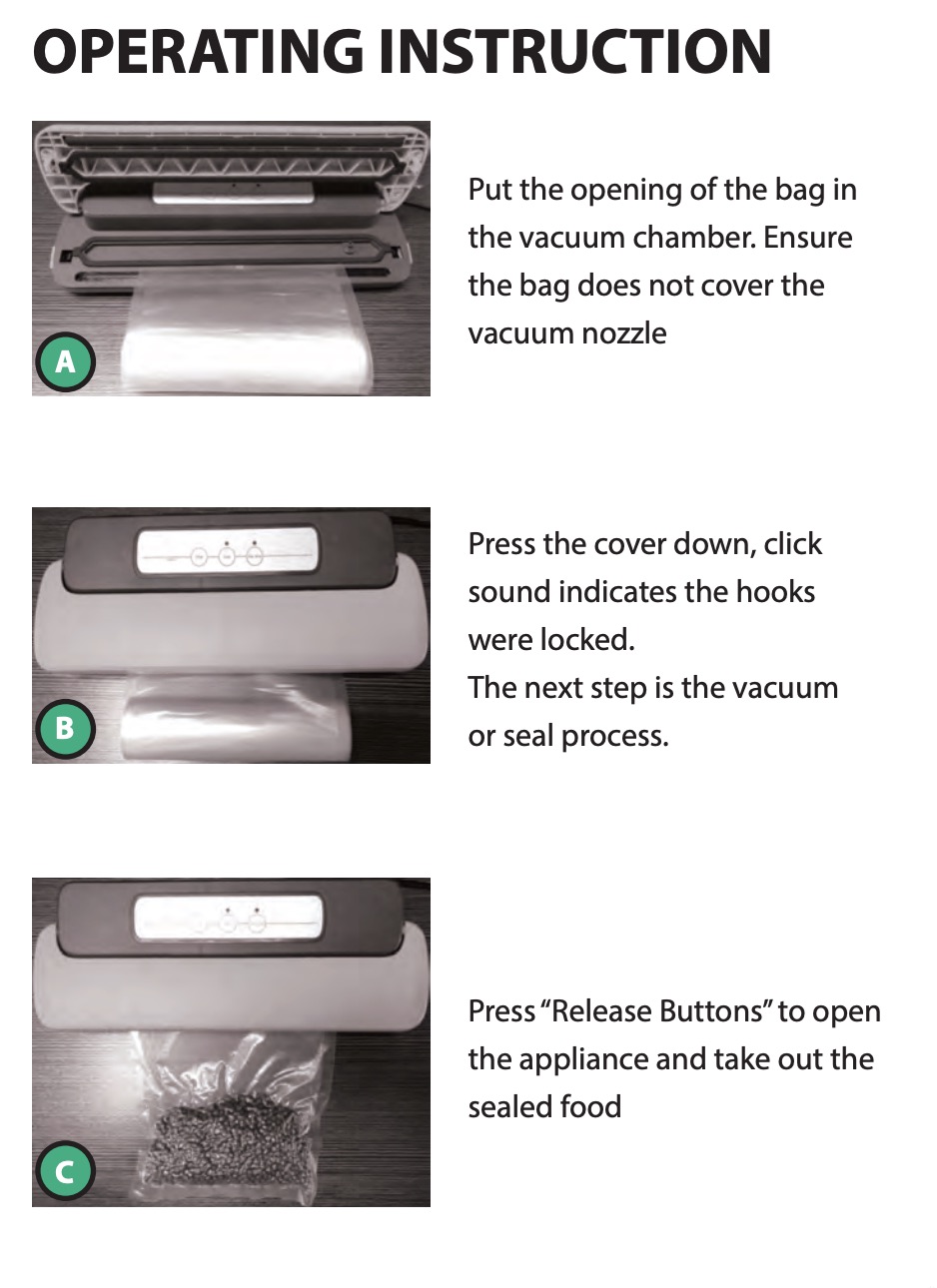
Note that this sealer doesn't have Dry/Moist functions, so if you want to seal liquids you will have to do so by careful observation and manually stopping the vacuum process before liquid gets sucked into the sealer. (This is actually simple to do--you just use the Stop button. When you're ready to seal, press the Seal button.)
Also note that closing the sealer is done with one hand (though it can be tough to lock down so you may need to use both hands to lock it), but there are two locks on either side of the sealer that you have to press to open it.
Specifications
Color: Black or white
Size: 5.2 x 14.57 x 2.56 in.
Weight: 2.2 lb
Max Bag Width: 11 in.
Power: 130W
Vacuum Strength:18 inHg
Edge Sealing without Vacuum Capability? Yes (Seal button)
Storage space for bags? No
Roll Cutter? No
Warranty: 1 year limited.
Included
5 Medium vacuum bags (7.8 x 11.8 in.)
1 Bag roll (7.8 x 79 in.)
Power cord.
Pros and Cons
Pros
Cons
Recommendation
If you want a lightweight little vacuum sealer (only 2 pounds!) with an accessory hose port, this is a nice sealer, especially if you already own a hose from an older sealer, as this one does not come with one. (Hoses from other brands should work fine.) However, we would probably go with another model, for about the same price, because this one does not have the accessory hose, Moist/Dry vacuum options, or the all-important a bag cutter. We recommend going with one of the PKVS25 or PKVS45 models instead, both of which have bag cutters and better vacuum features for about the same price (both reviewed above). If you want roll storage or a Pulse button, go with the PKVS30STS model for a little bit more (reviewed below).
BUY NUTRICHEF PKVS10bk (BLACK):

BUY NUTRICHEF PKVS10wt (White):
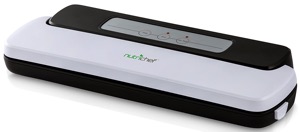
Review: PKVS18BK/PKVS18SL
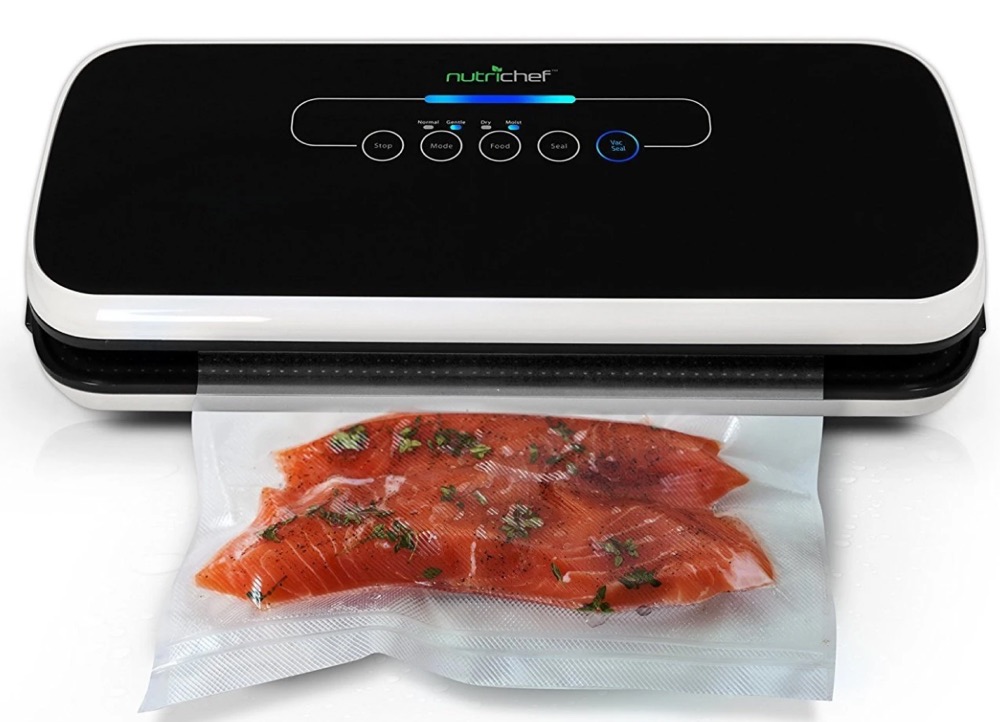
See PKVS18BK on Amazon (black)
See PKVS18SL on Amazon (stainless/silver)
About $60
Here's the stainless/silver model:
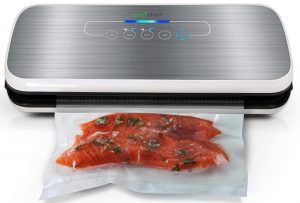
The PKVS18 is a middle-of-the-pack Nutrichef sealer. At about 3 pounds, it's a compact, lightweight sealer with good looks and basic functionality. Its best features are that it has several vacuum speeds (Dry/Moist, Normal/Gentle) and comes with a wine stopper. Its worst feature is that it has no bag cutter--which you may not miss if you don't have one, but will love if you do; it makes using rolls of bags, which are cheaper, a lot easier.
Some testers complained about how easy it was to accidentally trigger operation by brushing the buttons, so while it's a pretty little sealer--especially the stainless model--it may not be the most practical design.
Note also that all Nutrichef vacuum sealers have an accessory port and can be used with a bottle stopper, as well as other accessories; you just have to buy them separately.
Also, if you already own accessories like bottle stoppers, marinade containers, and mason jar lids from another brand of sealer, they should work just fine with any Nutrichef sealer.
Features
- Soft touch digital buttons
- LED indicator lights
- Dry/Moist sealing modes
- Normal/Gentle sealing modes
- Accessory port (hose incl.)
- 110W motor
- Rated at 12L/min (about 5 seconds to seal a 1 quart bag)
- 3mm seal width
- Vacuum strength about 18 inHg (from our testing)
- Generous starter kit
- 1 year limited warranty.
Operation
Operation is similar to other Nutrichef vacuum sealers. You have to place the bag in the chamber and press the lid down until it locks. Then you press the desired function and let the sealer do its job. Note that the Canister button is inside the sealer (for using the accessory hose):
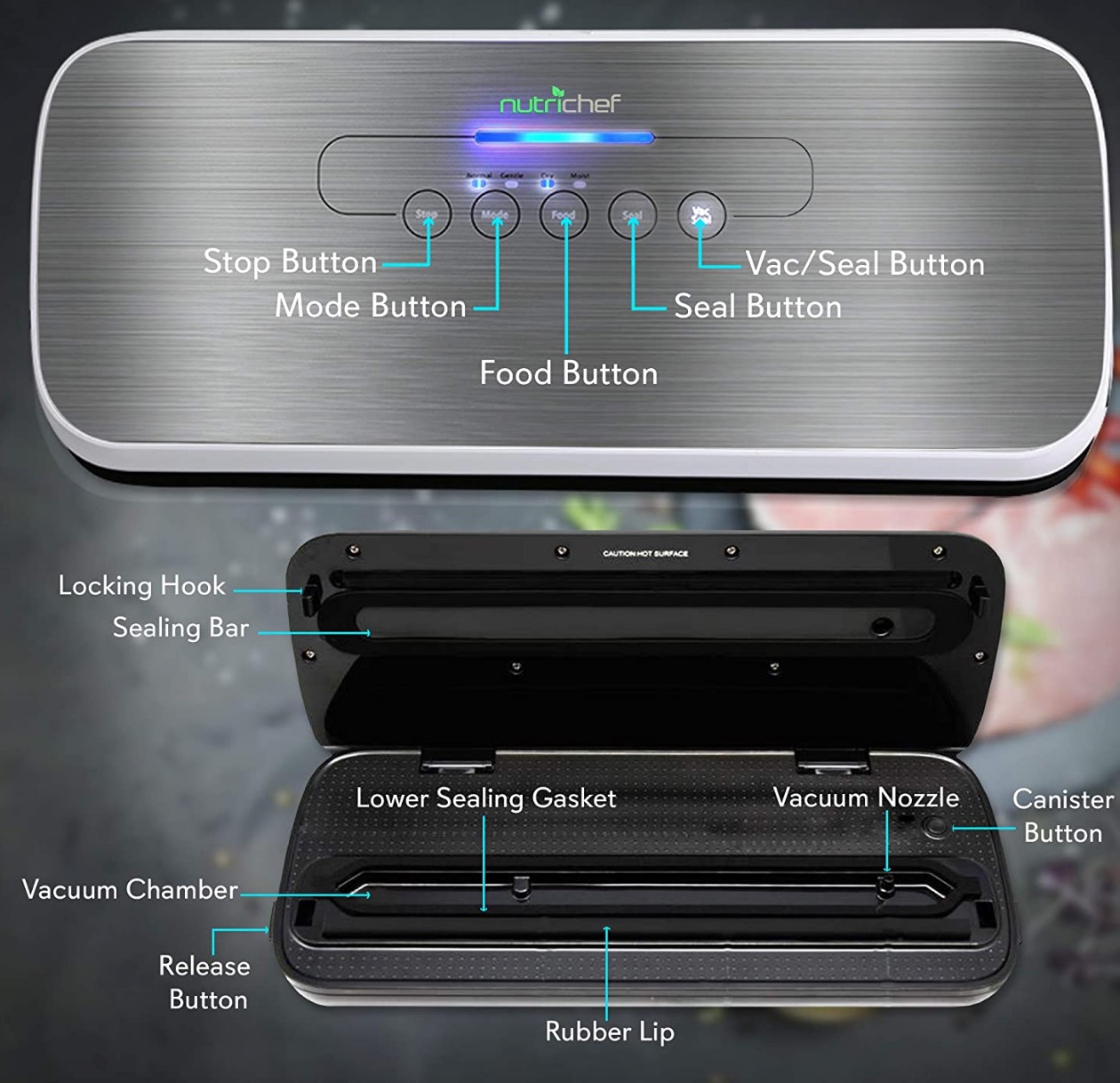
This sealer has Dry/Moist as well as Normal/Gentle buttons for maximum control over the sealing process. (Though these buttons do essentially the same thing, which is switching between normal and gentle vacuum power.)
Specifications
Color: Black or stainless
Size: 6.1 x 14.2 x 3.0 in.
Weight: 2.9 lb
Max Bag Width: 11 in.
Power: 110W
Vacuum Strength:18 inHg
Vacuum Speed: 12L/min
Edge Sealing without Vacuum Capability? Yes (Seal button)
Storage space for bags? No
Bag Cutter? No
Warranty: 1 year limited.
Included
5 Medium vacuum bags (7.8 x 11.8 in.)
1 Bag roll (7.8 x 79 in.)
Accessory Hose
Wine stopper (for use with accessory hose)
Power cord.
Pros and Cons
Pros
Cons
Recommendation
The Nutrichef PKVS18 is one of Nutrichef's best sellers. It has several vacuum speeds and the starter kit includes the accessory hose, several bags and a bag roll, plus a wine bottle stopper. However, there is no bag cutter with this model. You don't need a bag cutter but it does make using the bag rolls (which are cheaper than pre-made bags) a lot easier. The PKVS25 and PKVS45 models (both reviewed above) have a bag cutter for only slightly more, with the same starter kits (minus the wine bottle stopper).
BUY NUTRICHEF PKVS18 (both colors):
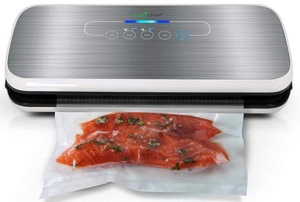
Review: PKVS35

About $70
The Nutrichef PKVS35 is a compact, pretty vacuum sealer. We like that the controls run along one side of the unit rather than sit on top--they're not as easy to accidentally trigger. We also like the one-handed operation, and how fast this model can evacuate air from a bag. Unfortunately it doesn't have a bag cutter, so if you want to use rolls (which are cheaper than pre-made bags), you'll be cutting them by hand. Believe us: you will love having a bag cutter.
This model, like all the other Nutrichef edge sealers we tested, also required fairly long cooldowns after just a few consecutive seals, making it not a great choice for bulk sealing projects.
Also, another small complaint is about the shiny stainless surface: it's pretty, for sure, but it really shows smudges easily.
Features
- Soft touch digital buttons
- LED indicator lights
- Dry/moist sealing modes
- 3mm seal width
- Accessory port (hose incl.)
- 110W motor
- Vacuum strength about 18 inHg
- Vacuum strength 14L/min (under 5 seconds per quart-sized bag)
- Generous starter kit
- 1 year limited warranty.
Operation
From the user manual, here is the control panel diagram:
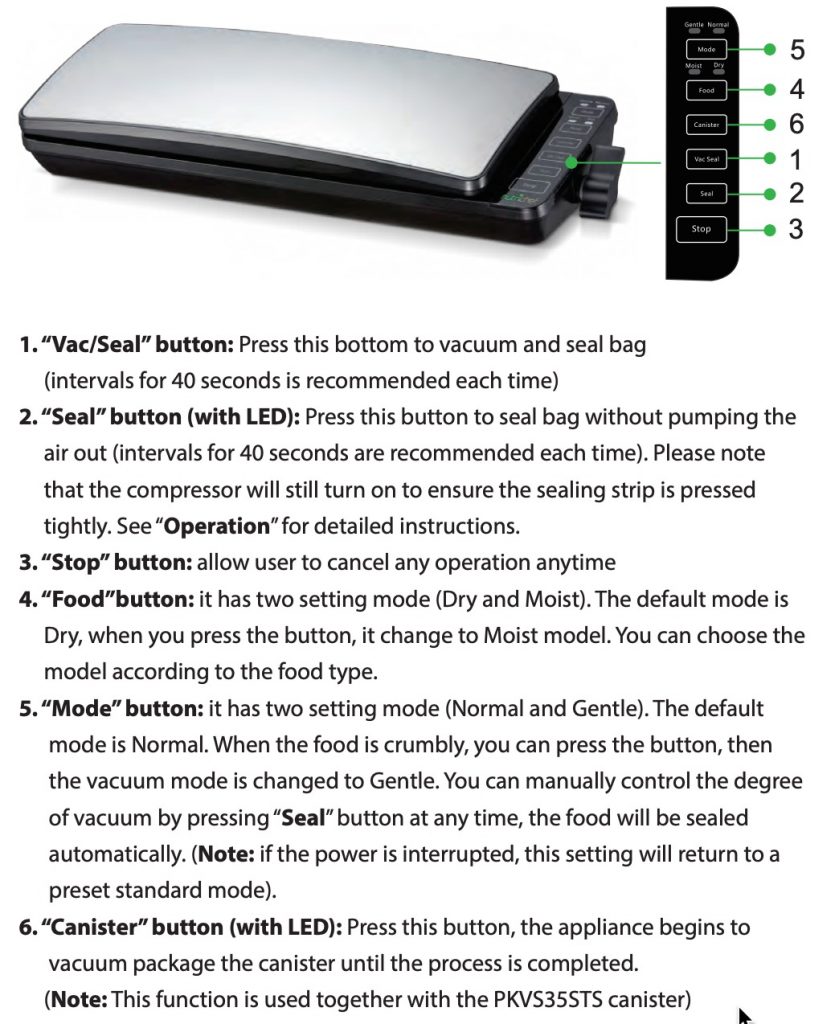
Here are the operating instructions, also from the manual:
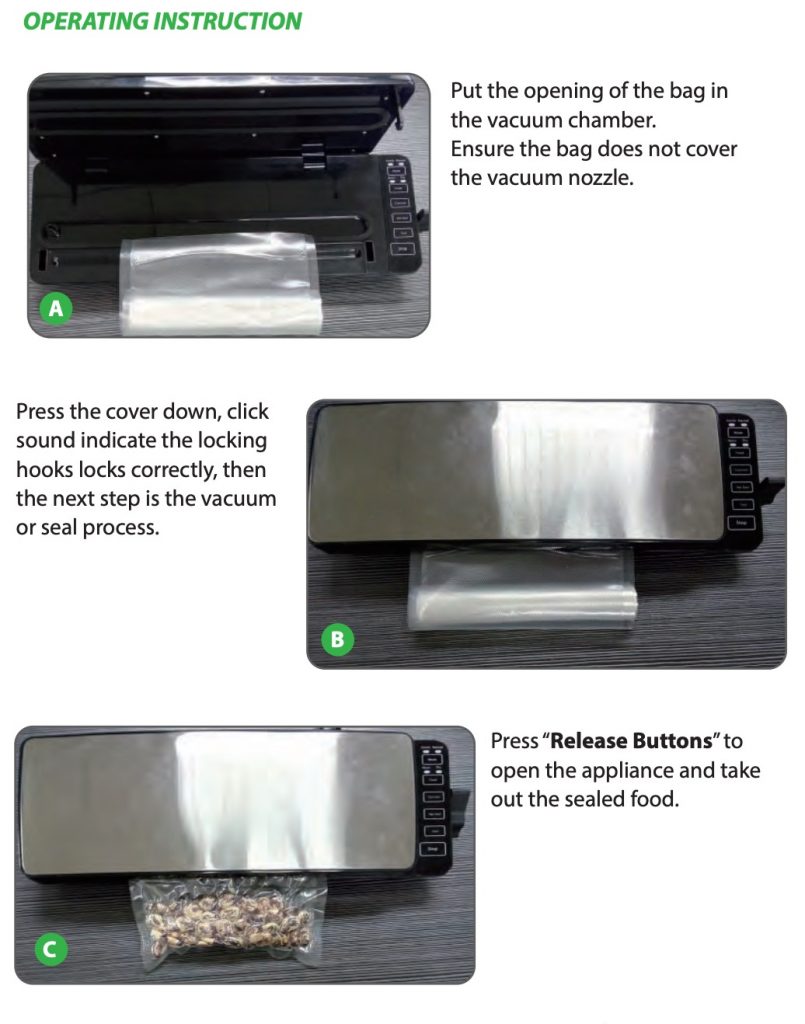
Specifications
Color: Black
Size: 16.3 x 5.31 x 3.2 in.
Weight: 3 lb
Max Bag Width: 11 in.
Power: 110W
Vacuum Strength:18 inHg
Vacuum Speed: 14L/min
Edge Sealing without Vacuum Capability? Yes (Seal button)
Storage space for bags? No
Roll Cutter? No
Warranty: 1 year limited.
Included
5 Medium vacuum bags (7.8 x 11.8 in.)
1 Bag roll (7.8 x 79 in.)
Accessory Hose
Power cord.
Pros and Cons
Pros
Cons
Recommendation
Rated at 14L/min, this is one of Nutrichef's fastest vacuum sealers. It has several vacuum speeds and we like all the controls along the right side--and love the one-handed release knob. If you're going to use it occasionally and not for large projects, it's a fine choice. However, we would go with a model that has a bag cutter, like the PKVS25 or PKVS45 (both reviewed above).
BUY NUTRICHEF PKVS35sts:

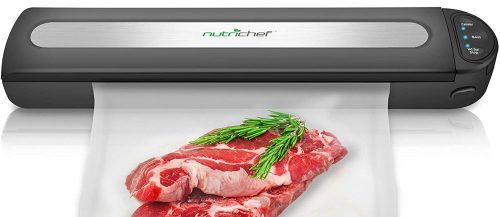
About $40
A very basic sealer with a very easy-to-use control panel. It has no vacuum speed options, which is fine as you can control vacuum strength by stopping the vacuum process at any time just by pushing the Vac Seal/Stop button. The bigger miss in our opinion is the lack of a bag cutter, which makes using rolls of bags so much easier.
We also dislike that you have to press release buttons on both sides of the unit so it requires two hands. Since there are other options for roughly the same price, the PKVS15 isn't one of our recommended models.
Features
- Soft touch digital buttons
- LED indicator lights
- Accessory port (hose incl.)
- Simple control panel
- 110W motor
- Vacuum strength about 18 inHg
- Vacuum speed 12L/min (about 5 seconds for a 1 qt. bag)
- Generous starter kit
- 1 year limited warranty.
Operation
The very simple control panel looks like this:
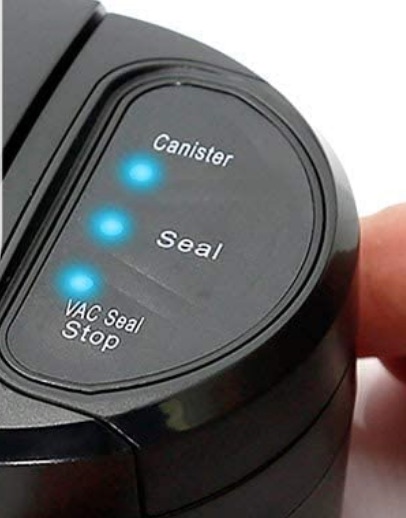
And here are the operating instructions from the user manual:
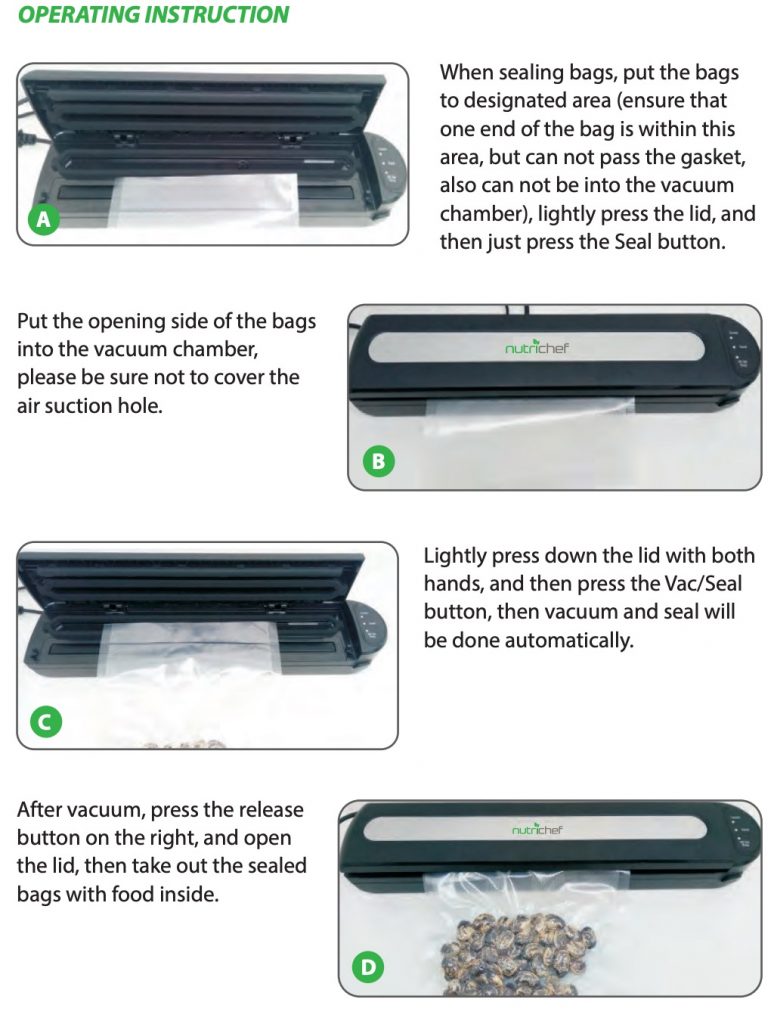
Specifications
Color: Black/stainless
Size: 15.75 x 3.15 x 2.17 in.
Weight: 2.2 lb
Max Bag Width: 11 in.
Power: 110W
Vacuum Strength:18 inHg
Vacuum Speed: 12L/min
Edge Sealing without Vacuum Capability? Yes (Seal button)
Storage space for bags? No
Roll Cutter? No
Warranty: 1 year limited.
Included
5 Medium vacuum bags (7.8 x 11.8 in.)
1 Bag roll (7.8 x 79 in.)
Accessory Hose
Power cord.
Pros and Cons
Pros
Cons
Recommendation
This is similar to other Nutrichef vacuum sealer models but without Dry/Moist modes and no bag cutter. You can live without vacuum speeds by simply stopping the vacuum before it crushes food, but the bag cutter is a big miss if you plan on using rolls of bags. Since the prices are all about the same, we recommend going with a model that has the same starter kit plus more vacuum speeds and the built-in bag cutter, like the PKVS25 or PKVS45 models (both reviewed above).
BUY NUTRICHEF PKVS15:

*Review: PKVS30STS

About $80
Buy for: bag cutter, Pulse button, bag roll storage, bottle stopper, and super fast vacuum speed.
We think this is the best Nutrichef vacuum sealer by far! The Nutrichef PKVS30STS costs a little more than some of the other Nutrichef models, but for many of you, it may be worth it. This is the only Nutrichef model with bag storage, and also the only Nutrichef sealer with a Pulse button--plus all the other great features like special sealing modes and a bag cutter. Because of the bag storage, it's the biggest Nutrichef vacuum sealer, but it still weighs just under 5 pounds.
With a vacuum speed of 24L/min, this is also Nutrichef's fastest vacuum sealer.
This sealer has all the bells and whistles and comes with a wine bottle stopper plus the generous bags, bag roll, and accessory hose. It's fast, small, holds a small roll of bags, and comes with a nice starter kit. In our opinion, it is Nutrichef's best edge sealers.
NOTE: We do not recommend paying more than about $80 for this sealer. Prices have been all over the map, but the actual retail price is $60-80.
Features
- Soft touch digital buttons
- LED indicator lights
- 3 sealing modes (dry, moist, pickling)
- Pulse mode
- Accessory port (hose incl.)
- 120W motor
- Vacuum strength is about 18 inHg
- Vacuum speed is 24L/min (about 3 seconds for a 1 qt bag)
- Bag storage and cutter
- Generous starter kit, including bottle stopper
- 1 year limited warranty.
Operation
Though there are several vacuum options, operation is easy, and the controls are straightforward to understand, as shown here:
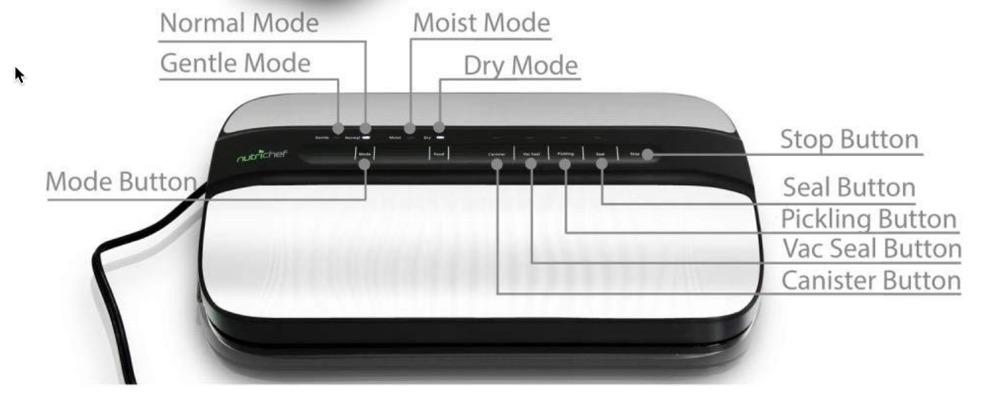
Just insert the bag and push down the lid until the sealer locks (this can take a little bit of effort). Then select the mode you want.
Specifications
Color: Stainless/black
Size: 8.1 x 15.8 x 4.0 in.
Weight: 4.86 lb.
Max Bag Width: 11 in.
Power: 120W
Vacuum Strength:18 inHg
Vacuum Speed: 24 L/min
Edge Sealing without Vacuum Capability? Yes (Seal button)
Storage space for bags? No
Roll Cutter? No
Warranty: 1 year limited.
Included
5 Medium vacuum bags (7.8 x 11.8 in.)
1 Bag roll (7.8 x 79 in.)
Accessory Hose
Wine stopper (for use with accessory hose)
Power cord.
Pros and Cons
Pros
Cons
Recommendation
Highly recommended: The PKVS30STS is our favorite Nutrichef vacuum sealer model by far. It has a lot of vacuum speed options including a pickling (e.g., marinade) mode. It's the fastest Nutrichef edge sealer on the market, and it has a bag cutter and roll storage. Granted, the storage space is small, but this keeps down the size and weight of the sealer. We also love the Pulse feature, which makes it easy to get the amount of vacuum pulled just right.
If you want bag storage, highly recommended. Also recommended for the Pulse feature, the only Nutrichef sealer that has one. If you want all the other features but don't care about bag storage or Pulse, go with either the PKVS25 and PKVS45 (both reviewed above).
BUY NUTRICHEF PKVS30STS ON AMAZON:

Review: PKVS40BK

The Nutrichef PKVS40BK is the only Nutrichef vacuum sealer with a digital readout that helps to guide you through the sealing process. It also has automatic Open/Close, so no pressing it down to lock it shut before sealing; it closes all by itself.
It has Dry/Moist modes, Normal/Gentle modes, and a Marinade mode for use with the accessory hose--included with the purchase.
It's a nice vacuum sealer because of the digital display and vacuum ,options, but at 8L/minute, it's on the slow side, and there's no bag cutter. For these reasons, it is not one of our recommended models.
Features
- Soft touch digital buttons
- LED indicator lights
- Digital display
- 3 sealing modes (dry, moist, marinade)
- Normal/gentle modes
- Accessory port (hose incl.)
- 120W motor
- Vacuum strength is about 18 inHg
- Vacuum speed is 8L/min (about 3 seconds for a 1 qt bag)
- Bag storage and cutter
- Generous starter kit
- 1 year limited warranty.
Operation
Because of the digital display and automatic sealing, operation is simple. Here's a diagram of the control panel and important parts of the machine:
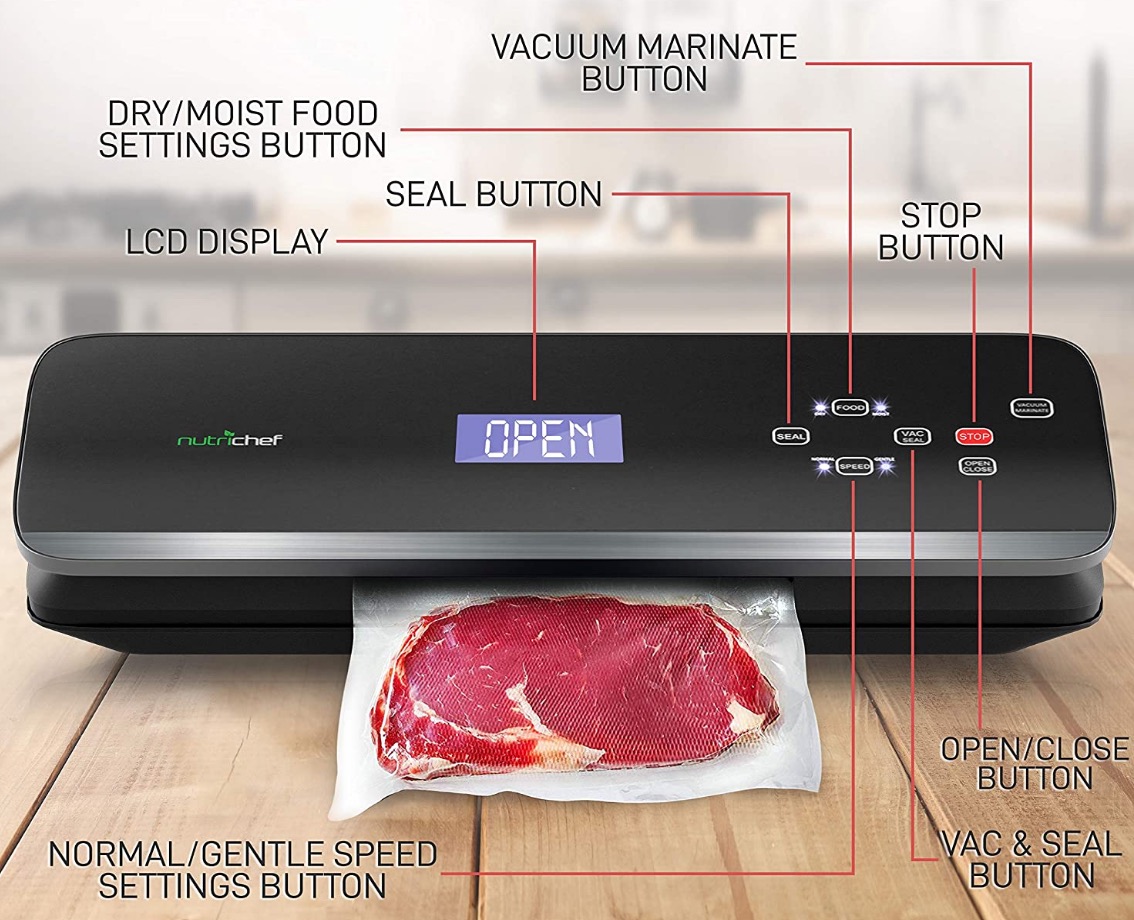
Note that opening and closing is also electronic--using the Open/Close button--so no difficulties pressing the lid shut to get it to shut tight.
The accessory hose attachment is also easy to use: just attach the accessory hose to the opening (inside the sealer) and use the Vacuum Marinate button to activate it.
Specifications
Color: Stainless/black
Size: 14.9 x 5.5 x 2.7 in.
Weight: 5.04 lb.
Max Bag Width: 11 in.
Power: 120W
Vacuum Strength:18 inHg
Vacuum Speed: 8 L/min
Edge Sealing without Vacuum Capability? Yes (Seal button)
Storage space for bags? No
Roll Cutter? No
Warranty: 1 year limited.
Included
5 Medium vacuum bags (7.8 x 11.8 in.)
1 Bag roll (7.8 x 79 in.)
Accessory Hose
Power cord.
Pros and Cons
Pros
Cons
Recommendation
Though the PKVS40BK looks modern and sleek, it lacks a bag cutter and is slow to vacuum bags, making it not one of our favorites. We recommend that you go with the PKVS25 and PKVS45 instead, or, if you also want bag storage or super fast vacuum power, the PKVS30STS.
BUY NUTRICHEF PKVS40BK:
Review: PKVS50STS Commercial Grade Vacuum Sealer

See NutriChef PKVS50STS vacuum sealer on Amazon
See NutriChef PKVS50STS vacuum sealer at Wal-Mart
About $160
NutriChef came out with a commercial grade edge sealer, and it's got a lot of good features, including a bag cutter, pulse button, an accessory port (hose included), different sealing modes, and more. But the best feature is the powerful vacuum: it has 400 watts and can pull up to 26 "Hg, which is more than any of the other NutriChef edge sealers. We also like the stainless steel body, although it adds weight: this sealer weighs about 16 pounds.
We had no issues with this sealer during testing. It was easy to use and pulled a strong vacuum. The accessory hose worked great, as did the "Pickling" setting (we would call this "marinade"). But there was a really high rate of negative reviews, with people saying it only worked a few times, then stopped pulling a vacuum, or that the seal didn't work, or that it didn't work at all out of the box. This sealer currently has a 1-star rating of 25%, which is too high for us to recommend it.
Features
- Soft touch digital buttons
- LED indicator lights
- Digital control panel/readout
- Gentle/Normal, Dry/Moist sealing modes
- Integrated bag cutter
- Pulse button
- 400W
- Accessory port
- Steel housing
- Includes an air hose, 10 bags (11x 15.7”) and 1 bag roll
Operation

Using this vacuum sealer is easy. There are buttons for all the operating modes and indicator lights to show you what mode you're in.
The accessory port is great for doing external containers like mason jars, wine bottles, and marinating containers. (Other brands of containers, such as FoodSaver, should work fine with this sealer.)
As with most edge sealers, the hardest part is getting the lid shut firmly enough so it can pull a vacuum. You'll get the hang of it, but your first few seals may not be great.
Specifications
Color: Stainless/black
Size: 19.50 x 11.40 x 5.90 in.
Weight: 18 lbs
Max Bag Width: 11 in.
Power: 400W
Vacuum Strength: 26 inHg
Vacuum Speed: 8 L/min
Edge Sealing without Vacuum Capability? Yes (Seal button)
Roll Cutter? Yes
Storage space for bags? No
Warranty: 1 year limited.
Included
Hose for accessory port
Power cable
10 bags (11” x 15.7”) and
1 bag roll (11” x 118”).
Pros and Cons
Pros
Cons
Recommendation
This is a great looking edge sealer and is heavy and robust enough to work great, but unfortunately, it has a high rate of customer complaints. The sealer worked fine during our testing, but because of the high number of 1-star reviews, we can't recommend it.

buy nutrichef pkvs50sts vacuum sealer:
Review: PKVS70STS Chamber Vacuum Sealer

See PKVS70STS chamber sealer on Amazon
See PKVS70STS chamber sealer at Wal-Mart (lower price, but often out of stock)
About $500
At about 46 pounds, this model is lighter than most chamber sealers on the market, yet heavy duty enough to provide robust sealing.
This is a standard chamber vacuum sealer, but the digital buttons make it easier to operate than some other chamber sealers. You have full control over the sealing process, and you can set the sealer to your desired settings.
Features of a chamber vacuum sealer:
- It can seal liquids
- Great for bulk sealing projects with little or no cool down period required between seals
- Chamber vacuum bags are considerably cheaper than edge sealer bags
- Can seal mason jars in the chamber.
The chamber on the PKVS70 is tall enough for pint-sized mason jars. (Note that this is not a substitute for canning.)
If you're a gardener, hunter, fisherman, or routinely have large sealing projects, a chamber sealer can be a good investment. Yes, the initial cost is higher, but the sealer will pay for itself within a year (two at the most) in less wasted food and the ability to buy food in bulk for long-term storage.
To learn more about chamber sealers, see our articles The Best Commercial Vacuum Sealers for Home Use and How Much Should I Spend on a Vacuum Sealer?
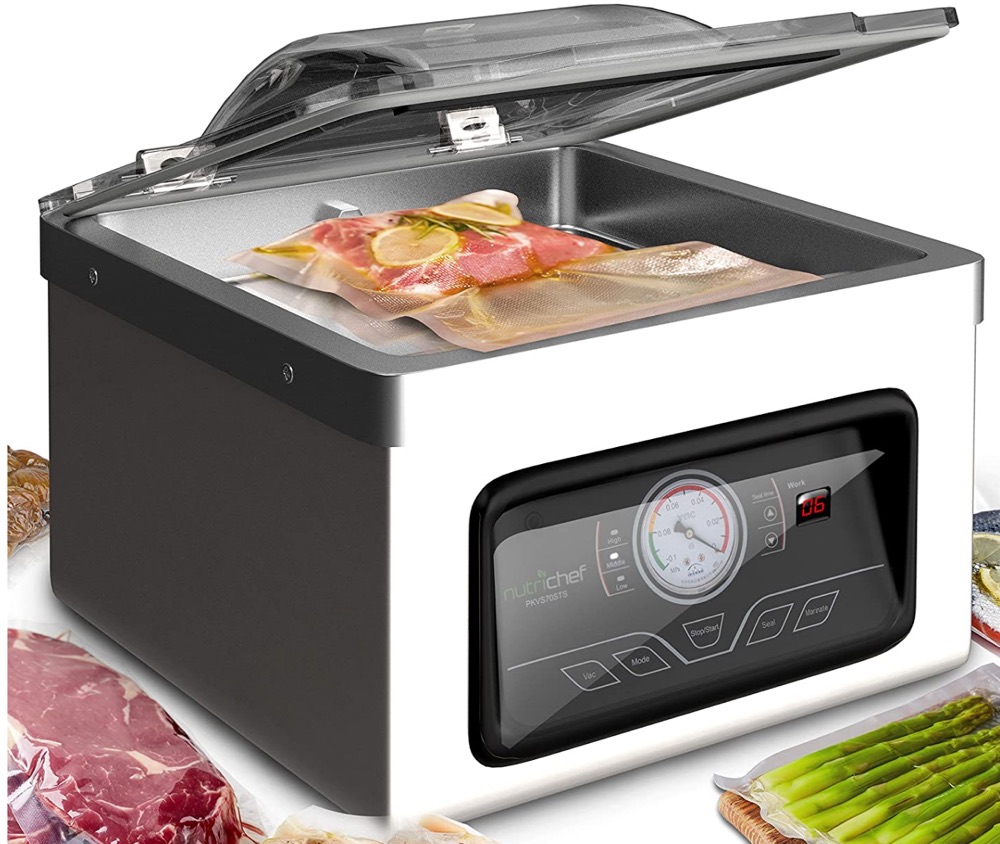
Features
- Digital buttons
- 8L chamber size
- Low, Med, Hi sealing modes
- Pressure gauge (shows vacuum process)
- 350W motor
- Vacuum strength: 26.6 inHg
- About 46 pounds
- Can seal liquids
- Generous starter kit
- 1 year limited warranty.
Operation
Though the gauge makes it look a little daunting, this chamber sealer is easy to operate. Here's what the control panel looks like:
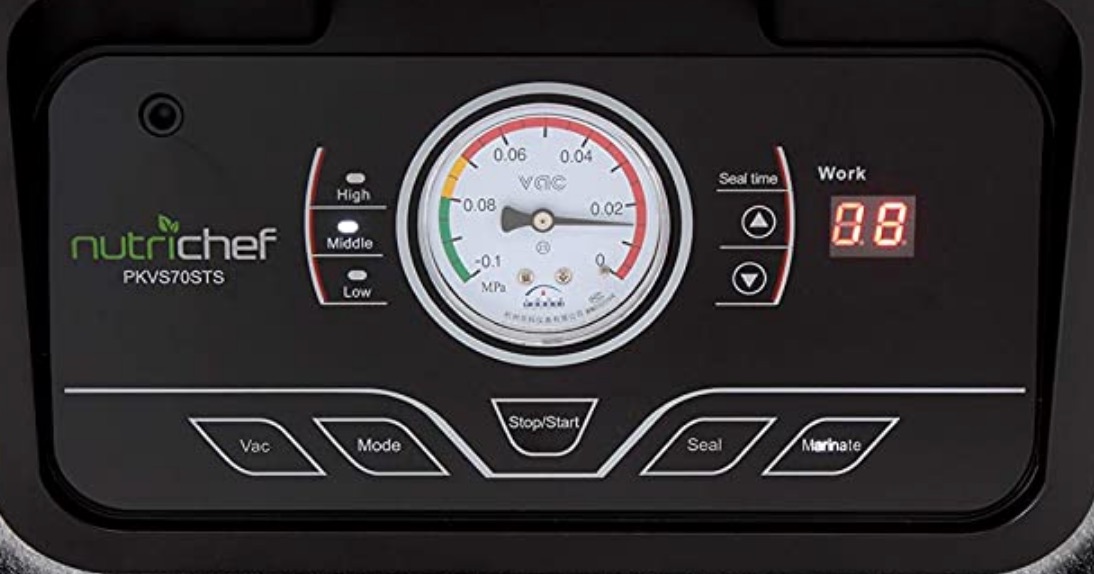
A chamber sealer is actually a lot easier to use than most edge sealers. You place the bag in the chamber with the edge right on the sealing bar, secure the lid, and start the process. You can observe the entire sealing process so if you need to alter it in any way, you can press the Stop button. You can also seal rolls of bags, or seal other bags without vacuuming, with the Seal button (a nice feature on a chamber sealer).
The Arrow keys to the right of the gauge are for setting the seal time, which can differ based on different bags. High, Medium, and Low helps with sealing soft or delicate foods. Both of these settings are done before the sealing process and will remain set until you change them. The buttons below are for individual sealing, which is easy to control with the Stop/Start, Mode, and Vac buttons.
Specifications
Color: Stainless/black
Size: 17.6 x 14.2 x 13.8 in.
Chamber Size: 13.8’ x 11.4 x 5.5 in.
Chamber Volume: 8L
Weight: 46 lb
Max Bag Width: 11 in.
Vacuum Strength: 26.6 inHg
Edge Sealing without Vacuum Capability? Yes
Storage space for bags? No
Roll Cutter? No
Warranty: 1 year limited.
Included
Accessory hose
10 large vacuum bags (11.0 x 15.7 in.)
1 vacuum seal bag roll (11. 0” x 9. 8’).
Pros and Cons
Pros
Cons
Recommendation
A chamber sealer is an investment, but for most people, it will pay for itself within a year or two. If you're looking for a heavy duty vacuum sealer, we recommend this model over any of the Nutrichef edge sealers. On the other hand, there are less expensive chamber sealers on the market that are just as good as this one, so you may want to keep shopping--again, see our article The Best Commercial Vacuum Sealers for Home Use for more info.
buy Nutrichef chamber sealer pkvs70sts:

Vacuum Sealer FAQs
Here are some common questions about vacuum sealers.
Is NutriChef a Good Brand of Vacuum Sealer?
The NutriChef brand is comparable to FoodSaver and Nesco. That is, it is marketed primarily to price-conscious buyers. You shouldn't expect commercial grade durability, but for the price, it is a dependable vacuum sealer.
Is a Vacuum Sealer Worth the Money?
This depends on many factors, but if you eat at home frequently and have a lot of leftovers, or if you like to buy in bulk to save money, or if you just hate to waste food, then a vacuum sealer can save you a lot. Over the course of a year, an average American family can save $2,000-$4,000 in less wasted food. So if you save just a fraction of this, a vacuum sealer will easily pay for itself.
Does Food Really Last Longer in a Vacuum Sealed Bag?
Yes, it does. Fresh food can last up to 2 weeks longer, and frozen food can last several months longer than non-vacuum sealed food.
How Does a Vacuum Sealer Work?
A vacuum sealer removes air from a bag, which means that air-borne pathogens are also removed. This allows food to stay fresher for longer.
Do You Need Special Bags to Use a Vacuum Sealer?
Yes, you do. An edge sealer in particular requires bags that are textured on the inside, which helps to "push" air out of the bag. Bags also have to be sturdy enough to seal properly; if they're too thin, the bag will melt, so it's always best to use bags designed to work with a vacuum sealer.
Does a Vacuum Sealer Prevent Freezer Burn?
A vacuum sealer can't prevent freezer burn completely, but it can greatly extend the time it takes for freezer burn to develop (up to several months).
Are There Any Foods You Can't Vacuum Seal?
You shouldn't vacuum seal raw onions, garlic, or mushrooms because these foods have a fairly high botulism risk in an anaerobic environment. You should also avoid vacuum sealing soft and delicate foods like bread, chips, and crispy taco shells, which will be crushed by vacuum sealing.
Are Vacuum Sealer Bags Recyclable?
Yes! Vacuum sealer bags are usually recyclable along with other plastic bags--but check with your local recylers to make sure. If you are able to recycle your vacuum sealer bags, be sure to rinse the bags out thoroughly before recycling.
Are Vacuum Sealer Bags Reusable?
Vacuum sealer bags are not designed to be re-used, but if you wash and dry them thoroughly, you may be able to use them again. It's best not to re-use bags that had raw meat or other foods likely to contain pathogens.
Final Thoughts on Nutrichef Vacuum Sealers
Nutrichef makes several basic, consumer grade edge sealers and one commercial grade chamber vacuum sealer. Depending on what you're looking for, a few of their models are worth buying.
We like:
PKVS25 (edge sealer with bag cutter, several vacuum modes, and decent vacuum speed)
PKVS45STS (edge sealer with bag cutter, automatic Open/Close button, several vacuum modes)
PKVS30STS (edge sealer with bag cutter, bag roll storage, several vacuum modes, Pulse, marinade, and fast vacuum speed)
All of the edge sealers run between $55-80, though you may find prices higher than that occasionally. We don't suggest paying more than $80 for any of these sealers.
We like the chamber sealer, too, but at just under $1000, it's a little high priced--there are less expensive chamber sealers on the market that are just as good (see above for links to more info, or go to our Vacuum Sealer Archives).
Thanks for reading!

If you found this article helpful, please share:
